new posts in all blogs
Viewing: Blog Posts Tagged with: reading aloud, Most Recent at Top [Help]
Results 26 - 50 of 221
How to use this Page
You are viewing the most recent posts tagged with the words: reading aloud in the JacketFlap blog reader. What is a tag? Think of a tag as a keyword or category label. Tags can both help you find posts on JacketFlap.com as well as provide an easy way for you to "remember" and classify posts for later recall. Try adding a tag yourself by clicking "Add a tag" below a post's header. Scroll down through the list of Recent Posts in the left column and click on a post title that sounds interesting. You can view all posts from a specific blog by clicking the Blog name in the right column, or you can click a 'More Posts from this Blog' link in any individual post.

By:
jilleisenberg14,
on 11/20/2014
Blog:
The Open Book
(
Login to Add to MyJacketFlap)
JacketFlap tags:
children's books,
holidays,
diversity,
Reading Aloud,
Adoption,
multicultural books,
Educators,
reading comprehension,
Educator Resources,
Multiracial,
Transracial adoption,
Common Core State Standards,
Holidays and Celebrations,
Add a tag
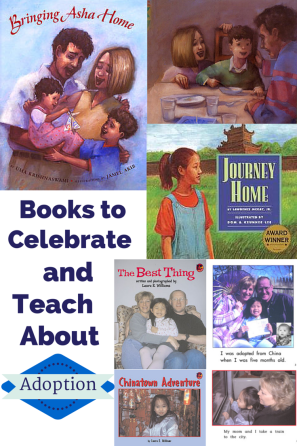
National Adoption Day this November 22 and National Adoption Month this November afford a time to share experiences and reflect on families. Whether you have students who have been adopted or are part of a family considering adopting a child into your home, all children can benefit from learning about adoption. Children are very curious about each other’s families, quick to categorize into groups, and intent to define what makes a family, well, a family.
Picture books provide a medium to discuss, celebrate, and learn about adoption and exploring the definition of “family.”
Book recommendations:
Bringing Asha Home

Journey Home

The Best Thing

Chinatown Adventure

Discussion Questions during and after reading:
- What does “family” mean to you? How might the word mean something different to people?
- What does it mean to be adopted? What might be some challenges for a family with an adopted child or for a child who is adopted? What might be some benefits for a family who adopt a child or for a child who is adopted?
- How is this character’s family similar to and different from your own family?
- How do this character and family share and have fun together? What do you enjoy doing with your siblings and family members?
- How does the character feel at the beginning, middle, and end of the story? How does the main character change from the beginning to the end of the story?
- How would you describe this character’s relationship with his/her parent in the story?
Activities:
- Learn more about the country from which the character is adopted. On which continent is the country located? What countries border this country? What language is spoken there? How many people live in that country? Who are some famous people from that country? Find a recipeof a food from this country to make.
- Share and reflect on this list of famous adoptees or adopters from TeacherVision by Beth Rowen.
- Draw a family portrait of your own family.
- Write a paragraph describing what makes your family unique and why you are proud of your family.
Further reading about adoption:
 Jill Eisenberg, our Senior Literacy Expert, began her career teaching English as a Foreign Language to second through sixth graders in Yilan, Taiwan as a Fulbright Fellow. She went on to become a literacy teacher for third grade in San Jose, CA as a Teach for America corps member. She is certified in Project Glad instruction to promote English language acquisition and academic achievement. In her column she offers teaching and literacy tips for educators.
Jill Eisenberg, our Senior Literacy Expert, began her career teaching English as a Foreign Language to second through sixth graders in Yilan, Taiwan as a Fulbright Fellow. She went on to become a literacy teacher for third grade in San Jose, CA as a Teach for America corps member. She is certified in Project Glad instruction to promote English language acquisition and academic achievement. In her column she offers teaching and literacy tips for educators.
Filed under:
Common Core State Standards,
Educator Resources,
Holidays and Celebrations Tagged:
Adoption,
children's books,
diversity,
Educators,
holidays,
multicultural books,
Multiracial,
Reading Aloud,
reading comprehension,
Transracial adoption 


By:
jilleisenberg14,
on 11/2/2014
Blog:
The Open Book
(
Login to Add to MyJacketFlap)
JacketFlap tags:
children's books,
Reading Aloud,
Educators,
reading comprehension,
close reading,
Educator Resources,
Common Core State Standards,
CCSS,
guided reading,
ELA common core standards,
Add a tag
In the fall of 2012 a news story emerged that astronomers had discovered a planet largely made out of diamond. Third grade at my school spent the first two quarters studying the solar system; therefore, this news was received with irrepressible glee in my classroom. Although the media nickname “Lucy” was lost on my students (as in the Beatles’ “Lucy in the Sky with Diamonds”), the wonderment and rejuvenated commitment to the content was obvious.
Seeing that scientists were still studying and discovering facts about our solar system and distant others was exciting to my students and made them feel like they were on the frontier learning alongside real astronomers. Pairing the news article with The Magic School Bus: Lost in the Solar System spurred very creative journal entries throughout the unit, including envisioned future discoveries of all sorts of substances for planets: kitten fur, gold, bubbles.
Incorporating current events and news stories into the classroom can engage students with a renewed sense of purpose and interest. Pairing a news article with a book on a similar topic or theme offers students greater context and a sense of relevancy for the content they are learning, and perhaps a jolt to the creeping apathy over a curriculum students had little input in selecting.
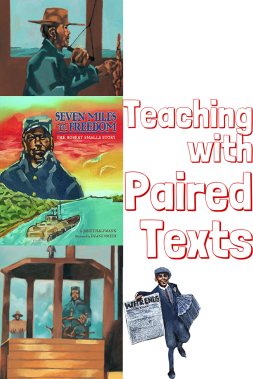 So, what does it look like to use paired texts in the classroom?
So, what does it look like to use paired texts in the classroom?
One example is using the picture book biography, Seven Miles to Freedom: The Robert Smalls Story. In May 2014, the National Oceanic and Atmospheric Administration (NOAA) announced it had discovered the Civil War ship of Robert Smalls. Pairing one of the articles with the picture book biography provides students opportunity to practice comprehension and the third component of the Common Core reading standards: integration of knowledge and ideas.
Standard 9: Analyze how two or more texts address similar themes or topics in order to build knowledge or to compare the approaches the authors take.
The following example can be adapted for grades 3–7. Read the picture book, Seven Miles to Freedom, aloud to the whole group or have students read to themselves depending on their reading level. Focus questions may look like this:
- How does the picture book describe Robert Smalls?
- What character trait would best describe Robert Smalls based on what he says, does, thinks, feels and what other characters say and think about him?
- Why do you think the author of the picture book wants to share this story with young people?
- How does this story help us better understand the events in Robert Smalls’ life?
Read the news article second. If the news article is above students’ reading level, read the article aloud as they follow along with individual copies. The questions for the article will mirror those questions for the picture book:
- How does the article describe Robert Smalls?
- What character trait would best describe Robert Smalls based on what he says and does and what other people quoted say and think about him in this article?
- Why do you think the NOAA’s Maritime Heritage Program wants to find and rescue the ship/signify the ship’s location now after all these years?
- How does this news article help us better understand the events in Robert Smalls’ life and the picture book Seven Miles to Freedom?
Follow up questions looking at both texts together:
- What events and details do both texts agree on?
- Create a timeline of events using both the picture book and news article.
- How are these texts both examples of nonfiction? What sub-genres of nonfiction are they? How do they present information similarly and differently?
Resources about Robert Smalls:
- Explore a reading guide and learning activities for Seven Miles to Freedom from OurStory, a website created by the Smithsonian’s National Museum of American History to encourage adults and children in grades K–4 to read historical fiction and biography together
- Read about Robert Smalls’ ship, Planter, and a report about the discovery from the Voyage to Discovery, a multi-media initiative to highlight African American maritime history from the NOAA’s Office of National Marine Sanctuaries’ Maritime Heritage Program and the National Association of Black Scuba Divers
Resources for connecting Lee & Low titles with news:
Bonus: A fragment from Amelia Earhart’s airplane was recently identified. What book would you want to pair with this news story for students? Share with us!

Jill Eisenberg, our Senior Literacy Expert, began her career teaching English as a Foreign Language to second through sixth graders in Yilan, Taiwan as a Fulbright Fellow. She went on to become a literacy teacher for third grade in San Jose, CA as a Teach for America corps member. She is certified in Project Glad instruction to promote English language acquisition and academic achievement. In her column she offers teaching and literacy tips for educators.
Filed under:
Common Core State Standards,
Educator Resources Tagged:
CCSS,
children's books,
close reading,
Educators,
ELA common core standards,
guided reading,
Reading Aloud,
reading comprehension 

.jpg?picon=1806)
By:
A Wilson,
on 10/28/2014
Blog:
An Awfully Big Blog Adventure
(
Login to Add to MyJacketFlap)
JacketFlap tags:
reading aloud,
Anna Wilson,
www.acwilsonwriter.wordpress.com,
www.annawilson.co.uk,
Bark and Read,
Pets As Therapy,
Read2Dogs,
reading to dogs,
the Kennel Club,
Add a tag
I have written quite a few books which include canine characters and thus often find myself asked to do strange things in the name of publicity. I have judged dog competitions, judged short story competitions about dogs, been to visit a veterinary surgery with a reader, taken my own dog to an event to publicise my books and "meet" my readers. However, by far and away the strangest event I was invited to was one sponsored by the Kennel Club called "Bark and Read".

In schools where there are a number of children who have difficulty reading aloud, specially trained dogs from the Pets As Therapy scheme can be sent in at lunchtime to sit and listen to children read. I was asked to attend such a session at Vallis First School in Frome in Somerset, near where I live. I took some of my books and was asked to read some of my stories to the visiting dog, Percy, a Clumber Spaniel. Percy was adorably gentle and quiet and sat and listened attentively as I read about my fictional dogs having adventures, getting into scrapes, and solving mysteries. When I finished, Percy patted an electronic button which announced I had done a "Good Job!" The children, who were extremely shy at meeting me, relaxed when they saw Percy listening to me read and were soon clamouring to have a go themselves. The teacher explained to me afterwards that the children in the group all had learning difficulties or were suffering with tricky home lives, and that this time with Percy once a week was giving them a quiet space in which to practise reading aloud and enjoying stories without worrying if they were making mistakes or reading books that were "too babyish" for them, etc.
Recently my sister mentioned that my nephew was not enjoying reading aloud and was becoming quite anxious when asked to do so at school. His teachers had suggested he practise at home, but he was reluctant to do that too. I told her about the Bark and Read scheme as my sister has two lovely Labradors who I thought might be good listeners. She immediately jumped at the idea of her son reading to the pets. And it has worked! My nephew now asks if he can read aloud to Scooby and Teasel, the Labs (and the cat, Wormy, not to be outdone, has slinked his way in on the act as well).
I would highly recommend this approach to anyone who has a child struggling with reading. I have a feeling that any pet would enjoy a good book. I know our tortoise is not averse to a bit of bedtime storytelling. So if you have a reluctant reader and can get your hands on a willing pet, put the two together and you might just see something magical happen.
If you are interested in the Bark and Read Scheme or Read2Dogs with Pets As Therapy, visit these websites:
Anna Wilson
Don’t stop the readin’…hold on to that read aloud feeling | Storytime Standouts
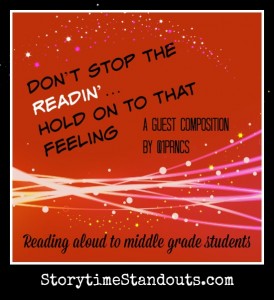 Some days I’m more “quirky” than others. This is one of those days. Instead of just telling you that your middle grade children (grades 4, 5, 6, 7) are not too old for you to keep up that nightly ritual of reading, I’ve made some alterations to a classic Journey song. You can laugh or roll your eyes, but the message will be the same. They’re getting older, but it doesn’t lessen their enthusiasm for books. Nor does it mean they don’t need us there to help them navigate some of the issues that their favourite characters are facing. Bottom line? Take fifteen minutes at the end of the night, curl up on someone’s bed, and keep reading.
Some days I’m more “quirky” than others. This is one of those days. Instead of just telling you that your middle grade children (grades 4, 5, 6, 7) are not too old for you to keep up that nightly ritual of reading, I’ve made some alterations to a classic Journey song. You can laugh or roll your eyes, but the message will be the same. They’re getting older, but it doesn’t lessen their enthusiasm for books. Nor does it mean they don’t need us there to help them navigate some of the issues that their favourite characters are facing. Bottom line? Take fifteen minutes at the end of the night, curl up on someone’s bed, and keep reading.

Don’t Stop the Readin’ (adapted from Journey’s Don’t stop believin’– hardcore Journey fans…I’m sorry  (ps: it helps if you listen to the song in the background softly so you can read with the beat)
(ps: it helps if you listen to the song in the background softly so you can read with the beat)
Just a grade five girl
Readin’ bout’ a wizard world
She read the whole series
Loved the characters
Just a grade six boy
Thinks he doesn’t like to read
He found The Outsiders
Thinks he’s Ponyboy
His father comes into the room
The moon is out the day is done
For a while they can read tonight
It goes on and on and on and on
Parents reading
Learnin’ bout the Hunger Games,
Heroes like Percy
Annabeth
Quests and danger
Find out what your kids are lovin’
Read with them every night
Workin’ hard to pay the bills
One on one time is such a thrill
Read a story, talk about your day
It’s worth the time
Picture Book
Non-Fiction
Doesn’t matter what you read
Graphic novels, Patterson
The list can go on and on and on
They aren’t too old
Even in the middle grades
Let them read to you
Read to them
Make it matter
A great way to stay connected
Just fifteen minutes a night
Don’t stop the readin’
Hold on to that feelin’
With your children
Don’t stop the readin’
Nielsen,
Sachar, Judy Blume
They keep you readin’
Keep on reading!
Don’t Stop Believin’ at Amazon.com
Don’t Stop Believin’: the Best of Journey at Amazon.ca
Storytime Standouts - Raising Children Who Love to Read
Storytime Standouts shares ten great reasons to read aloud to...A Wonderful Read Aloud Chapter Book: The Tale of Despereaux by Kate DiCamillo The Tale of Despereaux written by Kate DiCamillo and illustrated...A Quirky, Pleasant Read Aloud for 9-12 year olds – The Funeral Director’s Son The Funeral Director’s Son by Coleen Murtagh Paratore Chapter Book...

By:
jilleisenberg14,
on 9/21/2014
Blog:
The Open Book
(
Login to Add to MyJacketFlap)
JacketFlap tags:
children's books,
Reading Aloud,
Educators,
reading comprehension,
close reading,
Educator Resources,
Common Core State Standards,
CCSS,
ELA common core standards,
ELL/ESL and Bilingual Books,
Add a tag
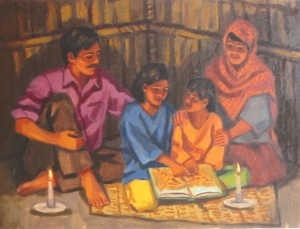 This week we are tackling what parents can do once they hear those magical words, “Your child has a Lexile score of…” For strategies for teachers and booksellers on navigating leveling systems and building a community, check out here and here.
This week we are tackling what parents can do once they hear those magical words, “Your child has a Lexile score of…” For strategies for teachers and booksellers on navigating leveling systems and building a community, check out here and here.
For parents who want to help your children find a book at their levels:
1. Ask teachers what leveling system they are using to assess your child’s reading growth.
- What does this system measure?
- What does a book at this level look like? Below-level book? Above-level book?
- What are examples of books and series that are on this level?
- Where can I find out more information about this leveling system and books measured using it?
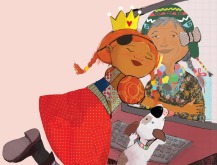 2. Research books and this leveling system for yourself online. Publishers and the leveling systems themselves often have books leveled. Additionally, there are many booklists already out there. Remember, your child isn’t the only one to ever have achieved a Lexile level 620. Someone has made a list before you.
2. Research books and this leveling system for yourself online. Publishers and the leveling systems themselves often have books leveled. Additionally, there are many booklists already out there. Remember, your child isn’t the only one to ever have achieved a Lexile level 620. Someone has made a list before you.
- For pre-made lists: Literacy organizations, such as Reading Rockets, ReadWorks.org, and Reading is Fundamental, have created top-notch reading lists. Libraries, such as Phoenix Public Library who built its own reader’s service to search titles by Lexile, often have ready-made booklists by grade and theme.
- To create your own: Search by book titles or by levels on Scholastic Book Wizard, Perma-Bound, Lexile’s Find a Book, Accelerated Reader BookFinder, and specific publishers like Lee & Low.
3. Do not assume that a library or bookstore will know what these levels are or mean. Ask your child’s teacher for a conversion chart to other leveling systems or download your own (see above). Download one from Reading Rockets, Booksource, Scholastic Guided Reading Program, Lexile, or Lee & Low. Also ask for booklists for Lexile levels the child should explore and take them with you to the library or bookstore.
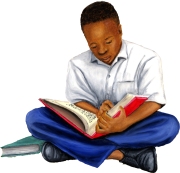 4. If you have a child who is reading significantly above his or her typical grade level and are concerned that higher levels equal too mature content or themes, look for expository nonfiction. Nonfiction often has higher technical and academic vocabulary bumping up the Lexile or Accelerated Reader levels (as they measure linguistic complexity), but the themes and concepts won’t be mature. Is your child reading a grade or two above peers and absolutely loved the science unit on forces and motion? Find sciences books that align with your child’s science or social studies units. Your child will be able to explore more in-depth about forces than will be covered in class. Check out the annual Robert F. Sibert Informational Book Medal winner and honors list and iNK (Interesting Nonfiction for Kids) Think Tank for award-winning nonfiction titles.
4. If you have a child who is reading significantly above his or her typical grade level and are concerned that higher levels equal too mature content or themes, look for expository nonfiction. Nonfiction often has higher technical and academic vocabulary bumping up the Lexile or Accelerated Reader levels (as they measure linguistic complexity), but the themes and concepts won’t be mature. Is your child reading a grade or two above peers and absolutely loved the science unit on forces and motion? Find sciences books that align with your child’s science or social studies units. Your child will be able to explore more in-depth about forces than will be covered in class. Check out the annual Robert F. Sibert Informational Book Medal winner and honors list and iNK (Interesting Nonfiction for Kids) Think Tank for award-winning nonfiction titles.
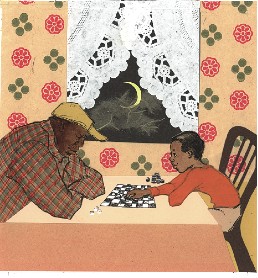 5. Most importantly, continue to expose your child to a wide range of genres, levels, and text sources. Just because your child achieved a Lexile level 920 doesn’t mean the child should only read books at a Lexile level 920. Your child’s teacher may assign homework with reading passages at specific reading levels, but it’s important for students to engage with texts that aren’t leveled as most books in bookstores and libraries won’t be. We interact with texts of all kinds throughout our day, including nutrition labels, newspaper articles, advertisements, recipes, and road signs. The real world does not provide children with texts at their level all the time and we need to work with them to develop reading strategies to cope when they come across more challenging texts. Moreover, we want our readers to develop their love of reading, along with skills and critical thinking. This may include our children seeking out and re-reading favorites or comfort books that happen to be lower leveled (who hasn’t indulged on a silly summer beach read every now and then?) or trying harder books that happen to be on their favorite subject (who can resist those stunning books filled with multisyllable Greek- and Latin-derived names of awe-inspiring dinosaurs?).
5. Most importantly, continue to expose your child to a wide range of genres, levels, and text sources. Just because your child achieved a Lexile level 920 doesn’t mean the child should only read books at a Lexile level 920. Your child’s teacher may assign homework with reading passages at specific reading levels, but it’s important for students to engage with texts that aren’t leveled as most books in bookstores and libraries won’t be. We interact with texts of all kinds throughout our day, including nutrition labels, newspaper articles, advertisements, recipes, and road signs. The real world does not provide children with texts at their level all the time and we need to work with them to develop reading strategies to cope when they come across more challenging texts. Moreover, we want our readers to develop their love of reading, along with skills and critical thinking. This may include our children seeking out and re-reading favorites or comfort books that happen to be lower leveled (who hasn’t indulged on a silly summer beach read every now and then?) or trying harder books that happen to be on their favorite subject (who can resist those stunning books filled with multisyllable Greek- and Latin-derived names of awe-inspiring dinosaurs?).
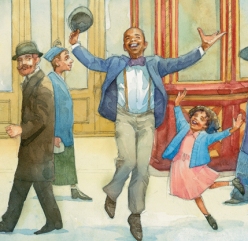 For further reading:
For further reading:
7 Strategies to Help Booksellers and Librarians Navigate Lexile
8 Strategies to Help Educators Explain Lexile and Invest Stakeholders
What have we missed? Please share in the comments your tricks, tips, and ideas for helping families and children navigate the bookshelves.
 Jill Eisenberg, our Resident Literacy Specialist, began her career teaching English as a Foreign Language to second through sixth graders in Yilan, Taiwan as a Fulbright Fellow. She went on to become a literacy teacher for third grade in San Jose, CA as a Teach for America corps member. She is certified in Project Glad instruction to promote English language acquisition and academic achievement. In her column she offers teaching and literacy tips for educators.
Jill Eisenberg, our Resident Literacy Specialist, began her career teaching English as a Foreign Language to second through sixth graders in Yilan, Taiwan as a Fulbright Fellow. She went on to become a literacy teacher for third grade in San Jose, CA as a Teach for America corps member. She is certified in Project Glad instruction to promote English language acquisition and academic achievement. In her column she offers teaching and literacy tips for educators.
Filed under:
Common Core State Standards,
Educator Resources,
ELL/ESL and Bilingual Books Tagged:
CCSS,
children's books,
close reading,
Educators,
ELA common core standards,
Reading Aloud,
reading comprehension 


By:
jilleisenberg14,
on 9/7/2014
Blog:
The Open Book
(
Login to Add to MyJacketFlap)
JacketFlap tags:
close reading,
Educator Resources,
Common Core State Standards,
CCSS,
ELA common core standards,
ELL/ESL and Bilingual Books,
children's books,
Bookselling,
librarians,
booksellers,
Reading Aloud,
Educators,
Add a tag
 I highly recommend all educators and parents read a bookseller’s perspective on leveling systems, Lexile in this case, which we re-posted on our blog last week. There are great firsthand examples of parents and booksellers striving in earnest to help children improve in reading.
I highly recommend all educators and parents read a bookseller’s perspective on leveling systems, Lexile in this case, which we re-posted on our blog last week. There are great firsthand examples of parents and booksellers striving in earnest to help children improve in reading.
Regardless of where one comes down on leveling books and assessing students with leveling systems, last week’s post laid bare the lack of or breakdown in communication between all stakeholders about the tools used to assess children’s reading growth.
Whether a child’s reading abilities are measured using Lexile, Accelerated Reader, DRA or another, we must equip any and all stakeholders in a child’s education with knowledge about what these tools mean and concrete ways to further support the child.
Children spend 7,800 hours outside of school each year compared to 900 hours in school. The National Center for Families Learning asserts that “the family unit—no matter the composition—is the one constant across the educational spectrum.” I am extending the definition of a child’s family to include afterschool volunteers, librarians, booksellers, pediatricians, and anyone else involved in a child’s education journey.
 Below are strategies for strengthening the communication lines, sharing resources and context, and building a community invested in each child’s education. In doing so, we show our students, children, and customers that they have a whole team cheering for them and invested in their growth, joy, and success.
Below are strategies for strengthening the communication lines, sharing resources and context, and building a community invested in each child’s education. In doing so, we show our students, children, and customers that they have a whole team cheering for them and invested in their growth, joy, and success.
This week we are tackling what librarians and booksellers can do in preparation for hearing those magical words, “My child has a Lexile score of…” Next week, we will offer strategies for teachers and parents.
For librarians and booksellers who are asked which book for which level:
- Know the local feeder schools to your library or store and ask teachers or the school librarians what leveling systems they are using. Find out how the classroom libraries are organized (by theme, genre, Lexile level, AR level, guided reading level, author). Reaching out to neighborhood schools helps you learn about your customers and build relationships with educators. Ask schools for any booklists or level conversion charts. Schools will be thrilled to recommend their families to places that know their curriculum, leveling systems, and community. Students may move on, but you and teachers are in it for the long haul.
- If schools use multiple or differing leveling systems, ask schools for level conversion charts to have on hand for customers or download your own from Reading Rockets, Booksource, Scholastic Guided Reading Program, Lexile, or Lee & Low. A conversion chart will help you translate what grade level a customer is reading on and books you can recommend within that range.
- Design your own booklists based on grade levels or popular leveling systems. Search by book titles or by levels on Scholastic Book Wizard, Perma-Bound, Lexile’s Find a Book, Accelerated Reader BookFinder, and specific publishers like Lee & Low. Parents and students can reference these handouts as they explore the store.
- Even better: Use other pre-curated lists of popular leveling systems. Remember, you are neither the only nor first bookseller to have a confused nine year old asking what they should read at a Lexile level 930. Share and reach out to teachers and school librarians who may have created lists from which parents and children are requesting. Other persistent souls are tackling these issues as well: Durham County Library and Phoenix Public Library both built a reader’s service to search titles by Lexile, as well as graded and themed booklists.
- Know the Common Core Appendix B text exemplar list. It may not be perfect, but many schools are using these texts to benchmark against other works. Recognizing these books will give you a sense of what the expectations are for each grade level and what students across the country are reading. Pair books in your store or library with this list to help readers discover more contemporary, diverse, and multicultural books.
- If you have children who are reading significantly above their typical grade level and parents that are concerned that higher levels equal too mature content or themes, encourage expository nonfiction. Nonfiction often has higher technical and academic vocabulary bumping up the Lexile or Accelerated Reader levels (as they measure linguistic complexity), but the themes and concepts won’t be mature. When I had three students who were reading two plus grade levels above their peers, I sought out more STEM books that aligned with my third-grade science units, the solar system and animal adaptations. They were able to explore more in-depth about black holes and gravity than we could cover whole group.
- Remember ELL, EFL, ESL, and non-English speaking families. You will most likely have at least a few parents whose first language is NOT English. They will rely even more heavily on you (librarians and bookstore staff) for help finding the right fit book for their child. The more you learn about leveling systems and engage with the neighborhood schools, the more you help the child.

Next week, we will offer strategies for teachers and parents.
What have we missed? Please share in the comments your tricks, tips, and ideas for helping families and children navigate the bookshelves.
 Jill Eisenberg, our Resident Literacy Specialist, began her career teaching English as a Foreign Language to second through sixth graders in Yilan, Taiwan as a Fulbright Fellow. She went on to become a literacy teacher for third grade in San Jose, CA as a Teach for America corps member. She is certified in Project Glad instruction to promote English language acquisition and academic achievement. In her column she offers teaching and literacy tips for educators.
Jill Eisenberg, our Resident Literacy Specialist, began her career teaching English as a Foreign Language to second through sixth graders in Yilan, Taiwan as a Fulbright Fellow. She went on to become a literacy teacher for third grade in San Jose, CA as a Teach for America corps member. She is certified in Project Glad instruction to promote English language acquisition and academic achievement. In her column she offers teaching and literacy tips for educators.
Filed under:
Common Core State Standards,
Educator Resources,
ELL/ESL and Bilingual Books Tagged:
booksellers,
Bookselling,
CCSS,
children's books,
close reading,
Educators,
ELA common core standards,
librarians,
Reading Aloud 


By:
jilleisenberg14,
on 8/16/2014
Blog:
The Open Book
(
Login to Add to MyJacketFlap)
JacketFlap tags:
diversity,
Reading Aloud,
Educators,
reading comprehension,
close reading,
ELA common core standards,
children's books,
Educator Resources,
Common Core State Standards,
CCSS,
ELL/ESL and Bilingual Books,
Add a tag
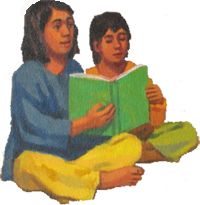 As we cluster in workshops, around webinars, and near the water cooler, we are already thinking about and preparing what skills and knowledge we want to teach. Yet, to truly have a successful year, let’s ponder an additional question: who do we want to teach?
As we cluster in workshops, around webinars, and near the water cooler, we are already thinking about and preparing what skills and knowledge we want to teach. Yet, to truly have a successful year, let’s ponder an additional question: who do we want to teach?
The start of school is a popular time to model and instill core values because August and September are a fresh start: our time as teachers, librarians, and administrators to create and cultivate a community bound and motivated by the same values and goals. It is during this period that we can expose our students to stories with strong morals that feature both examples and non-examples of how to react in tough situations and learn from one’s mistakes.
However, it can be very difficult to select just the right text to teach values that will guide our students through academic and developmental challenges over the coming year and lay the groundwork for the community we hope to build.
Many teachers dust off their tried-and-true character education read alouds each coming school year or rely on word of mouth recommendations that send us back to the classics year in, year out. During my first year of teaching, I remember everyone scrambling to find a book that demonstrated “respect” or “persistence.” When a master teacher on campus mentioned that she used a particular title for the start of every first week of school, that sounded like hard proof to me and I was grateful. I went out and bought it.
Yet, there is not just one book that will make the abstract concept of “empathy” or “leadership” concrete to third graders or kindergartners. With such dependence on the same books, many of my third graders had read The Lorax three years in a row to learn about responsibility and respect. It’s an outstanding book to explore these values, but still…three years? It was time to shake things up.
Whether your school has campus-wide core values or you can determine your own, I encourage you to think carefully about which books you use to teach core values. They are the foundation of a classroom or school’s culture and can guide children’s social, intellectual, and emotional development.
For successful character education study, choose a set of books that:
1. 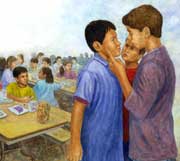 Have protagonists that both exemplify and struggle with at least one of the classroom’s core values. Don’t just present stories with perfect, role model-worthy characters! Students should see multiple examples of people and situations of the core value in action to learn that one’s character is made, not born. Finding books where characters (protagonists and antagonists) lie, cheat, lose their cool, or are hurtful to other characters can be just as powerful as exemplary characters, if not more so. Students can discuss what they can learn from both examples and non-examples, share advice for different scenarios, and reflect on similar experiences in their lives where they struggled to make the right decision.
Have protagonists that both exemplify and struggle with at least one of the classroom’s core values. Don’t just present stories with perfect, role model-worthy characters! Students should see multiple examples of people and situations of the core value in action to learn that one’s character is made, not born. Finding books where characters (protagonists and antagonists) lie, cheat, lose their cool, or are hurtful to other characters can be just as powerful as exemplary characters, if not more so. Students can discuss what they can learn from both examples and non-examples, share advice for different scenarios, and reflect on similar experiences in their lives where they struggled to make the right decision.
2. Are both fiction and nonfiction. Pair fiction with nonfiction texts to show students a range of experiences and real world applications. Reading a biography of a famous leader practicing or struggling with a core value gives students the chance to visualize the core value in their environment and daily lives, as well as let them see that knowing how to make good choices doesn’t come naturally and needs to be practiced.
3. Align with the Common Core ELA Standards. Character education doesn’t need to be separate from ELA instruction or your curriculum. In fact, core value study is great for teaching close reading, determining central ideas and author’s message, analyzing word choice, and comparing two or more texts.
4.  Have protagonists students can identify with based on race, gender, family background, language, and experience. Although students absolutely learn from characters different from themselves, it is very meaningful for children to see someone on the cover and in the pages they identify with struggling or succeeding to make good choices. Especially for younger students, relating to aspects of a character’s identity helps students visualize themselves in the character’s situation and develop empathy. Additionally, for children who are new to school or are English Language Learners, having characters that remind them of themselves or their families may give the children more confidence to participate in class, which is critical to building a strong classroom/school community at the beginning of the year.
Have protagonists students can identify with based on race, gender, family background, language, and experience. Although students absolutely learn from characters different from themselves, it is very meaningful for children to see someone on the cover and in the pages they identify with struggling or succeeding to make good choices. Especially for younger students, relating to aspects of a character’s identity helps students visualize themselves in the character’s situation and develop empathy. Additionally, for children who are new to school or are English Language Learners, having characters that remind them of themselves or their families may give the children more confidence to participate in class, which is critical to building a strong classroom/school community at the beginning of the year.
Looking to refresh your character education read aloud shelf? For book recommendations demonstrating your classroom’s core values, check out our Pinterest boards:

What core values do you teach children? What are your favorite books to teach these core values? Let us know below!
 Jill Eisenberg, our Resident Literacy Expert, began her career teaching English as a Foreign Language to second through sixth graders in Yilan, Taiwan as a Fulbright Fellow. She went on to become a literacy teacher for third grade in San Jose, CA as a Teach for America corps member. She is certified in Project Glad instruction to promote English language acquisition and academic achievement. In her column she offers teaching and literacy tips for educators.
Jill Eisenberg, our Resident Literacy Expert, began her career teaching English as a Foreign Language to second through sixth graders in Yilan, Taiwan as a Fulbright Fellow. She went on to become a literacy teacher for third grade in San Jose, CA as a Teach for America corps member. She is certified in Project Glad instruction to promote English language acquisition and academic achievement. In her column she offers teaching and literacy tips for educators.
Filed under:
Common Core State Standards,
Educator Resources,
ELL/ESL and Bilingual Books Tagged:
CCSS,
children's books,
close reading,
diversity,
Educators,
ELA common core standards,
Reading Aloud,
reading comprehension 

You don’t have to be a kid in elementary school to listen to a book read aloud. You don’t have to be the parent of a preschooler to read aloud.

By:
jilleisenberg14,
on 8/10/2014
Blog:
The Open Book
(
Login to Add to MyJacketFlap)
JacketFlap tags:
children's books,
diversity,
Immigration,
Reading Aloud,
Educators,
reading comprehension,
Race issues,
Educator Resources,
Latino/Hispanic/Mexican,
ELL/ESL and Bilingual Books,
Add a tag
What an amazing week to see the response of last Sunday’s post and hear what many of you are facing, doing, and aspiring to in schools and communities. In addition to using children’s books to initiate conversations, deepen background knowledge, and humanize the events, here are eleven teaching resources to help you provide the best information, context, and perspective for your students.
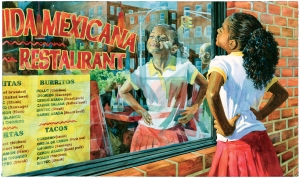
- Colorín Colorado is a free bilingual service that presents information, activities, and advice for educators and Spanish-speaking families of English Language Learners. One of my favorite sections is “Reaching Out to ELL Students and Families” because it gives explicit tools on how to create a welcoming classroom environment, learn about our students’ backgrounds, and reach out to parents of ELLs.
- Educators For Fair Consideration (E4FC) offers educator guides to support teachers and school staff in supporting undocumented students in school and beyond graduation.
- Colorlines contributes award-winning daily reporting, investigative news, and analysis on issues of race with a subsection devoted to child migrants. They also have a campaign, Drop the I-Word.
- The Library of Congress has curated thousands of resources, especially primary sources and online exhibitions, on immigration in the United States providing critical historical context to current events. I strongly recommend checking out the presentation, Immigration: The Changing Face of America, where students can read the immigration history of specific ethnicities and races, and the Themed Resources: Immigration, where students can study the contributions of American immigrants.
- The staff at the Latin American and Iberian Institute (University of New Mexico) have created and organized thematic guides, lesson plans, and news articles for issues related to Latin America available at the Latin America Data Base.
- Teaching Tolerance, a project of the Southern Poverty Law Center, provides award-winning educational materials to teachers, including immigration-themed units and lessons.
- Border Crossers has prepared a list of resources for adults to learn how to teach and talk about race and racial justice with students.
- The Migrant Policy Institute, a Washington, DC think tank, offers powerful analysis of global and regional migration. I want to underscore their visual tools, such as the International Migrant Population by Country of Origin and Destination map.
- Accompanying the two PBS documentary series, Latino Americans and The New Americans, are rich lesson plans and activities for grades 7 and up to explore the diverse experiences of coming to America.
- Latin@s in Kid Lit has an extensive list of children’s literature for those looking for more beyond our eleven book list, as well as interviews and teaching ideas.
- The MY HERO Project enables students to create, share, and discover stories, audio, art, and films that promote tolerance, peace, and diversity. Teacher resources are available at MY HERO Teacher’s Room.
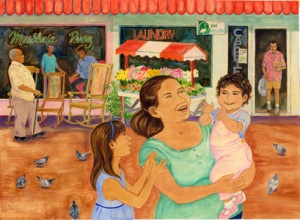 For further reading:
For further reading:
11 Books on Latin American Immigration and Migration
What resources would you add? What resources do you recommend? Please share them with our community in the comments!
Filed under:
Educator Resources,
ELL/ESL and Bilingual Books Tagged:
children's books,
diversity,
Educators,
Immigration,
Latino/Hispanic/Mexican,
Race issues,
Reading Aloud,
reading comprehension 


By:
jilleisenberg14,
on 8/2/2014
Blog:
The Open Book
(
Login to Add to MyJacketFlap)
JacketFlap tags:
children's books,
events,
diversity,
Immigration,
Reading Aloud,
Educators,
reading comprehension,
close reading,
Race issues,
Educator Resources,
Common Core State Standards,
Latino/Hispanic/Mexican,
ELL/ESL and Bilingual Books,
Add a tag
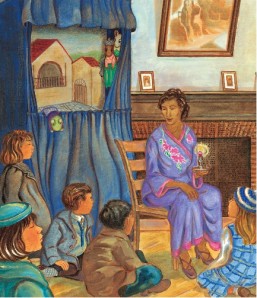 As media coverage has intensified around the events of children crossing the U.S. border, many educators and families are wondering, “What should we tell our students?” For some children, this may be the first time they are learning of these countries. But for many others, these events may involve their own heritage or depict their families’ experiences. Using books to talk about the recent events can be an opportunity to learn about a new region and help children see the cultures and people beyond these events.
As media coverage has intensified around the events of children crossing the U.S. border, many educators and families are wondering, “What should we tell our students?” For some children, this may be the first time they are learning of these countries. But for many others, these events may involve their own heritage or depict their families’ experiences. Using books to talk about the recent events can be an opportunity to learn about a new region and help children see the cultures and people beyond these events.
We’ve put together a list of 11 books (many of which are bilingual English/Spanish) that teach about the emotional journey families and children must undertake along with the physical journey. These stories allow children to see each other and themselves in characters who are living life to the fullest and refusing to let any obstacle stand in their way.
Whether you are looking to explore the themes of the DREAM Act, learn more about the journey of one’s own family, or see America from a different angle, these books reveal the complexities, challenges, joys, and surprises of coming to a new place. Join these characters as they share their challenges and excitement in moving to a new culture and new school, helping their families adjust, and juggling their home culture with a new culture.
 1. A Movie in My Pillow/ Una película en mi almohada
1. A Movie in My Pillow/ Una película en mi almohada
Poet Jorge Argueta evokes the wonder of his childhood in rural El Salvador, a touching relationship with a caring father, and his confusion and delight in his new urban home.
 2. Amelia’s Road
2. Amelia’s Road
Amelia longs for a beautiful white house with a fine shade tree in the yard, where she can live without worrying. In this inspirational tale, Amelia discovers the importance of putting her own roots down in a very special way.

3. First Day in Grapes
Chico and his family move up and down the state of California picking fruits and vegetables. Every September Chico starts at a new school again. Often other children pick on him, but Chico’s first day in third grade turns out to be different.
 4. From North to South/ Del Norte al Sur
4. From North to South/ Del Norte al Sur
José loves helping Mama, but when Mama is sent back to Mexico for not having proper papers, José and his Papa face an uncertain future. Author René Colato Laínez tackles the difficult and timely subject of family separation with exquisite tenderness.
 5. Home at Last
5. Home at Last
Ana Patino is adjusting well to her new life in the United States, but her mother is having a difficult time because she doesn’t speak English. After mama agrees to take English lessons, her sense of confidence and belonging grow.
 6. My Diary from Here to There/ Mi diario de aqui hasta allá
6. My Diary from Here to There/ Mi diario de aqui hasta allá
Amada overhears her parents whisper of moving from Mexico to the other side of the border—to Los Angeles. As she and her family make their journey north, Amada records her fears, hopes, and dreams for their lives in the United States in her diary.
 7. The Storyteller’s Candle/ La velita de los cuentos
7. The Storyteller’s Candle/ La velita de los cuentos
The award-winning team of Lucia González and Lulu Delacre have crafted an homage to Pura Belpré, New York City’s first Latina librarian. Through Pura Belpré’s vision and dedication, the warmth of Puerto Rico comes to the island of Manhattan in a most unexpected way.
 8. The Upside Down Boy/ El niño de cabeza
8. The Upside Down Boy/ El niño de cabeza
Juanito is bewildered by the new school and everything he does feels upside down. But a sensitive teacher and loving family help him to find his voice and make a place for himself in this new world.
 9. When This World Was New
9. When This World Was New
It is Danilito’s first day in America and he is scared. He has heard that some Americans are not friendly to foreigners. In addition, he does not speak any English. Danilito’s worries disappear when Papa leads him on a magical trip of discovery.
 10. Xochitl and the Flowers/ Xóchitl, la Niña de las Flores
10. Xochitl and the Flowers/ Xóchitl, la Niña de las Flores
Miles away from their home in El Salvador, Xochitl and her family make a new home in the United States, but nothing is the same. It is not until her family decides to start a flower nursery in its backyard that Xochitl begins to learn the true value of community in their adopted country.
 11. Calling the Doves/ El canto de las palomas
11. Calling the Doves/ El canto de las palomas
Poet Juan Felipe Herrera shares the story of his migrant farmworker childhood. The farmworker road was the beginning of his personal road to becoming a writer.
 Jill Eisenberg, our Resident Literacy Expert, began her career teaching English as a Foreign Language to second through sixth graders in Yilan, Taiwan as a Fulbright Fellow. She went on to become a literacy teacher for third grade in San Jose, CA as a Teach for America corps member. She is certified in Project Glad instruction to promote English language acquisition and academic achievement. In her column she offers teaching and literacy tips for educators.
Jill Eisenberg, our Resident Literacy Expert, began her career teaching English as a Foreign Language to second through sixth graders in Yilan, Taiwan as a Fulbright Fellow. She went on to become a literacy teacher for third grade in San Jose, CA as a Teach for America corps member. She is certified in Project Glad instruction to promote English language acquisition and academic achievement. In her column she offers teaching and literacy tips for educators.
Filed under:
Common Core State Standards,
Educator Resources,
ELL/ESL and Bilingual Books Tagged:
children's books,
close reading,
diversity,
Educators,
events,
Immigration,
Latino/Hispanic/Mexican,
Race issues,
Reading Aloud,
reading comprehension 


By:
jilleisenberg14,
on 7/27/2014
Blog:
The Open Book
(
Login to Add to MyJacketFlap)
JacketFlap tags:
Race issues,
Multiracial,
Educator Resources,
Diversity, Race, and Representation,
Reading Aloud,
reading comprehension,
children's books,
diversity,
Educators,
Add a tag
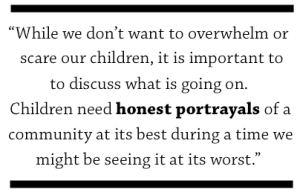 Breaking stories, developing crises, and unexpected catastrophes often involve more than one country, community, and culture. As our children listen in to the radio while stuck in traffic or the evening news program over dinner, it can be easy to think that if we don’t explicitly bring up the news story, then our children don’t know it’s happening.
Breaking stories, developing crises, and unexpected catastrophes often involve more than one country, community, and culture. As our children listen in to the radio while stuck in traffic or the evening news program over dinner, it can be easy to think that if we don’t explicitly bring up the news story, then our children don’t know it’s happening.
In fact, children are incredibly perceptive when their parents and adults close to them are distracted by news or alarming events. Many children also pick up information from their peers.
While we don’t want to overwhelm or scare our children, it is important to discuss what is going on. Children need honest portrayals of a community at its best during a time we might be seeing it at its worst.
How do we talk to children about these events and use these moments as opportunities to have respectful, honest (albeit age-appropriate) discussions?
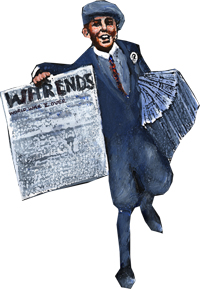
Picture books are invaluable conversation starters. Conflicts and disasters have complex origins and multiple players. Issues of race, class, religion, and gender are often entangled in the events or portrayal of the events. Children’s books dealing with conflict or natural disasters can frame the event in contexts and meanings suitable to their developmental stage. Stories with children as the main characters allow children to identify with the characters over universal themes.
When a “newsworthy” event happens, this may be the first time the child learns of this country, group of people, or culture. By the same token, the conflict or event may involve the child’s own heritage or culture. Using picture books to talk about a current event or conflict can be an opportunity to learn about a new region and help children see the culture and people beyond this event.
Instead of allowing the media to define the group of people involved, we should seek out and read a book showcasing and reinforcing the positive aspects and pride of the featured group of people and region. In doing so, we present a broader perspective of the community, culture, or people that media coverage is portraying in a negative, humiliating, or victimized light.
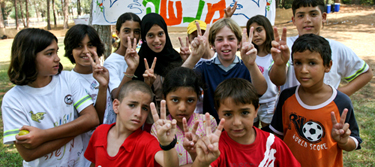
In selecting the right book to foster respect and provide an honest portrait of a community in the news, consider:
Books that champion human dignity:
Books that exhibit the strength, courage, and resilience of children:
Books that depict a community’s capacity to endure, love, and give:
“Age-appropriate” can mean truthful, thoughtful conversations. When talking to children, let them guide the discussion. Opening conversation starters include:
- What questions do you have? What have you heard?
- What do you know about the situation or group of people/foreign country involved?
- Who are the countries or communities involved?
- How are different communities and countries coming together over this issue?
- What would you like to do to help?
For further reading:
 Jill Eisenberg, our Resident Literacy Expert, began her career teaching English as a Foreign Language to second through sixth graders in Yilan, Taiwan as a Fulbright Fellow. She went on to become a literacy teacher for third grade in San Jose, CA as a Teach for America corps member. She is certified in Project Glad instruction to promote English language acquisition and academic achievement. In her column she offers teaching and literacy tips for educators.
Jill Eisenberg, our Resident Literacy Expert, began her career teaching English as a Foreign Language to second through sixth graders in Yilan, Taiwan as a Fulbright Fellow. She went on to become a literacy teacher for third grade in San Jose, CA as a Teach for America corps member. She is certified in Project Glad instruction to promote English language acquisition and academic achievement. In her column she offers teaching and literacy tips for educators.
Filed under:
Diversity, Race, and Representation,
Educator Resources Tagged:
children's books,
diversity,
Educators,
Multiracial,
Race issues,
Reading Aloud,
reading comprehension 


By:
jilleisenberg14,
on 7/20/2014
Blog:
The Open Book
(
Login to Add to MyJacketFlap)
JacketFlap tags:
Summer,
Reading Aloud,
summer reading,
Educators,
reading comprehension,
close reading,
Educator Resources,
ELA common core standards,
children's books,
Add a tag

I and I Bob Marley
Each week this summer, we are pairing Lee & Low titles to your favorite summer destinations with fun activities!
Summer is an incredible time to hear and enjoy music. From public parks to local high school auditoriums to subway platforms, many towns and cities offer summer concerts. Whether it is part of an official concert series, a festival, a rehearsal, or an impromptu get-together of musicians, there are a ton of opportunities to enjoy music alongside reading.
Our motto this summer: Love Books + Keep Cool + Learn Something New
Your summer outing: an Outdoor Summer Concert
Book recommendations:

Summoning the Phoenix
Questions during reading:
- What instruments are used in the book?
- What type of music is featured in this book?
- How is the music in this book different from other kinds of music?
- How does music create community?
- What character traits does someone need to become a successful musician?
- Why do you think people enjoy music and find it meaningful?
- Why do you think every culture has created some form of music?
Activities:
- Pair the book with a music recording or live performance of the same type of music featured in the book. What instruments do you hear? What patterns do you hear? What mood/tone does the music set? How does this music make you feel (unhappy, excited, calm, agitated)? How many musicians are performing? Is there a band leader/conductor for this type of music?
-
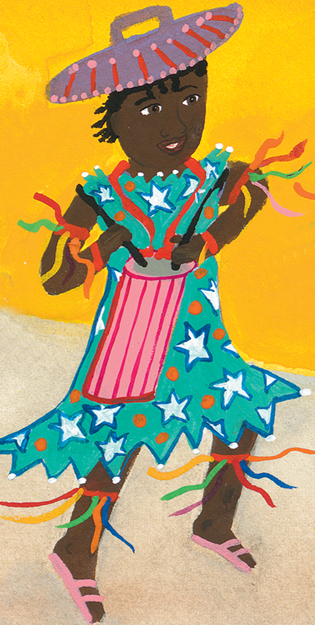
Drummer Boy of John John
Design and create a drum! Although many cultures and forms of music have distinct instruments, it is fascinating to note what instruments seem to pop up over and over again. Take for example the drum! Variations of the drum appear in music from all over the world. Check out the drum instructions from Spark!Lab, part of the Lemelson Center for the Study of Invention and Innovation at the National Museum of American History.
- Turn listening to music into seeing music! Talk about the senses we use to enjoy music. Children may think we can enjoy music with only our ears. Yet, the author and illustrator of the book had to communicate the music and its mood through words and pictures. What words does the author use to describe the featured music? What words does the author use to capture the mood of the music? What colors or actions does the illustrator use to capture the music? After attending a concert or listening to a recording, encourage your child to draw a picture that captures the mood, feeling, or story of the song. What colors would you use for each instrument and why? How would you draw a quiet, slow, fast, or loud moment?
-
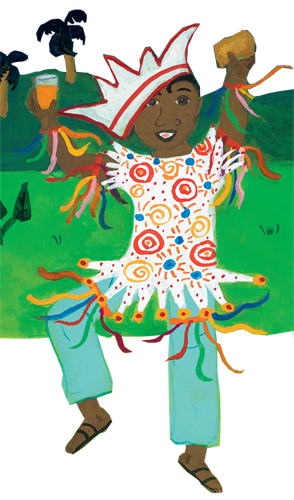
Drummer Boy of John John
Study the geography of the music featured in the book. Where does this type of music originate? Who are famous composers, contributors, or musicians? What kinds of instruments were/are used? Out of what materials from the region were instruments traditionally made?
For further summer reading and ideas:

Jill Eisenberg, our Resident Literacy Expert, began her career teaching English as a Foreign Language to second through sixth graders in Yilan, Taiwan as a Fulbright Fellow. She went on to become a literacy teacher for third grade in San Jose, CA as a Teach for America corps member. She is certified in Project Glad instruction to promote English language acquisition and academic achievement. In her column she offers teaching and literacy tips for educators.
Filed under:
Educator Resources,
Summer Tagged:
children's books,
close reading,
Educators,
ELA common core standards,
Reading Aloud,
reading comprehension,
summer,
summer reading 


By:
jilleisenberg14,
on 7/13/2014
Blog:
The Open Book
(
Login to Add to MyJacketFlap)
JacketFlap tags:
Reading Aloud,
summer reading,
Educators,
environmentalism,
reading comprehension,
close reading,
Summer School,
Educator Resources,
children's books,
Summer,
Add a tag
Grab a flashlight, bug repellent, and binoculars…
Each week this summer, we are pairing Lee & Low titles to your favorite summer destinations with fun activities!
Your summer outing: national or state parks!
Book recommendations:
Questions during reading:
- How have humans affected the habitat or animal species in the book?
- What suggestions does this book offer to take care of the world around us?
- What risks does the animal species or habitat face in the book?
- How does this person(group) demonstrate respect for the environment?
- How do healthy animal populations and habitats benefit people?
- What happens when people do not take care of the environment or an animal species in the book?
- What does this text teach about sustainability?
- Do you think communities and governments have a responsibility to protect animals or the environment? Why or why not?
- Should school field trips include visiting national and state parks? Why or why not? What are the benefits of children visiting national and state parks?
Activity:
1. Sound scavenger hunt!
Many animals rely on sound to detect nearby predators and search for food. For your next scavenger hunt, use the sense of sound to explore the wonders of the state or national park. This activity is a great way to teach young scientists about:
- our five senses
- how the human ear, like other animal ears, is a powerful physical adaptation and is very effective in detecting and differentiating sounds
- how we can appreciate natural beauty as both visual and aural
- the importance of slowing down and soaking in all the stimuli around us
Make a list of sounds for your child to “find” on the next hike. Together, check off and record as the child hears them! While you will want to adapt specific sounds to the park you are visiting, sound ideas include:

Everglades Forever
- the local bird species
- the rustling of an animal in the bushes
- the wind among grass or tree leaves
- sound of the nearest water source (river, ocean)
- the buzzing/humming of insects
- sound of walking on different types of surfaces: the trail, through leaves, in mud
- a hiker whistling
- a swimmer splashing
- a dog barking or the clinking of a dog collar
- sound of something being recycled
- sound of something hollow
- an echo
- sound of food being unwrapped
- horse clopping/trotting
- a stick snapping
- a hiker drinking (chugging) water
- Bonus: the elusive spot of complete silence
To prove that your child experienced the sound, allow your child to:
- record the sounds on a phone
- take a picture of the creature or thing making the noise
- describe the noise in a sentence with a juicy verb, such as chirping instead of singing
2. Animal and ecosystem observation!

Buffalo Song
Even if your nearest state or national park does not have the wildlife or habitat featured in the book, your young scientist can check out the featured animals or habitat in real life and real time from a computer or mobile device. Many national parks, zoos, and wildlife protection groups offer real-time footage of animals that serve as great opportunities to talk about behavioral and physical adaptations and habitat preservation.
Explore.org offers multiple livecam opportunities to observe wild animals outside of zoos. After finishing Buffalo Song, I checked out Canada’s Grasslands National Park for bison. I observed brown bears and salmon from Alaska’s Brooks River in Katmai National Park following I Know the River Loves Me. After A Man Called Raven, I used The Cornell Lab of Ornithology Macaulay Library for videos and audio recordings of ravens.

I Know the River Loves Me
For further book and activity suggestions to match your summer adventure:
 Literacy Specialist, Jill Eisenberg, began her career teaching English as a Foreign Language to second through sixth graders in Yilan, Taiwan as a Fulbright Fellow. She went on to become a literacy teacher for third grade in San Jose, CA as a Teach for America corps member. She is certified in Project Glad instruction to promote English language acquisition and academic achievement. In her column she offers teaching and literacy tips for educators.
Literacy Specialist, Jill Eisenberg, began her career teaching English as a Foreign Language to second through sixth graders in Yilan, Taiwan as a Fulbright Fellow. She went on to become a literacy teacher for third grade in San Jose, CA as a Teach for America corps member. She is certified in Project Glad instruction to promote English language acquisition and academic achievement. In her column she offers teaching and literacy tips for educators.
Filed under:
Educator Resources,
Summer Tagged:
children's books,
close reading,
Educators,
environmentalism,
Reading Aloud,
reading comprehension,
summer,
summer reading,
Summer School 


By:
jilleisenberg14,
on 7/6/2014
Blog:
The Open Book
(
Login to Add to MyJacketFlap)
JacketFlap tags:
children's books,
holidays,
diversity,
Summer,
Reading Aloud,
summer reading,
Educators,
reading comprehension,
close reading,
Educator Resources,
Holidays and Celebrations,
Add a tag
Each week this summer, we are pairing Lee & Low titles to your favorite summer destinations with fun activities!
Our motto this summer: Love Books + Keep Cool + Learn Something New
Your summer outing: the BEACH
Book recommendations:

Surfer of the Century: The Life of Duke Kahanamoku
Questions during reading:
- What is this person’s relationship to the ocean? How does this person’s relationship to the ocean change from the beginning to the end of the story?
- How does this person show appreciation for the ocean?
- How is the ocean/beach a part of this person’s identity?
- Look at a map of the world and locate the island this person is from. What is the capital? What ocean surrounds it? Infer what the climate is like based on the island’s location. What makes this island unique?
- How does this person demonstrate pride in his/her culture?
- How does this person remember home even when far away from home?
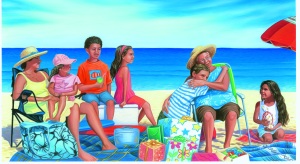 Activity:
Activity:
Create a beach ball collage!
Materials: poster paper, pencil, markers, colored pencils or crayons, assortment of magazines
- Using a pencil, draw a large circle on the poster paper.
- Inside the circle, draw a small circle about the size of a quarter somewhere off center.
- Draw a curved line from the small circle to the large circle. Repeat drawing lines until you have six lines and six spaces. Each curved line should face the same direction in a pinwheel formation. The lines will be different lengths and can be varying widths apart from each other (this will give it a 3-D effect).
- With a black marker, trace over the pencil so the beach ball stands out on the poster paper.
- Optional: lightly fill in each segment a different color using colored pencils or crayons.
- Select and cut out pictures and words from the assortment of magazines to answer the question: What makes the beach special to you?
- In each of the six beach ball segments, draw or glue pictures. In one section, think about what foods you eat while at the beach. What animals have you seen at the beach? What do you always make sure to pack before you head out? What activities do you like to do at the beach? Who do you play with while there?
For further reading:
 Jill Eisenberg, our Resident Literacy Expert, began her career teaching English as a Foreign Language to second through sixth graders in Yilan, Taiwan as a Fulbright Fellow. She went on to become a literacy teacher for third grade in San Jose, CA as a Teach for America corps member. She is certified in Project Glad instruction to promote English language acquisition and academic achievement. In her column she offers teaching and literacy tips for educators.
Jill Eisenberg, our Resident Literacy Expert, began her career teaching English as a Foreign Language to second through sixth graders in Yilan, Taiwan as a Fulbright Fellow. She went on to become a literacy teacher for third grade in San Jose, CA as a Teach for America corps member. She is certified in Project Glad instruction to promote English language acquisition and academic achievement. In her column she offers teaching and literacy tips for educators.
Filed under:
Educator Resources,
Holidays and Celebrations,
Summer Tagged:
children's books,
close reading,
diversity,
Educators,
holidays,
Reading Aloud,
reading comprehension,
summer,
summer reading 


By:
jilleisenberg14,
on 7/1/2014
Blog:
The Open Book
(
Login to Add to MyJacketFlap)
JacketFlap tags:
Reading Aloud,
parents,
Educators,
bilingual education,
reading comprehension,
hispanic heritage,
Educator Resources,
Latino/Hispanic/Mexican,
dual language,
ELA common core standards,
ELL/ESL and Bilingual Books,
Add a tag

Peggy McLeod, Ed. D. is Deputy Vice President of Education and Workforce Development at the National Council of La Raza (NCLR).
 Today we are featuring one of First Book’s celebrity blog series. Each month First Book connects with influential voices who share a belief in the power of literacy, and who have worked with First Book to curate a unique collection that inspires a love of reading and learning. All recommended books are available at deeply discounted prices on the First Book Marketplace to educators and programs serving children in need. Peggy McLeod, Ed. D. the Deputy Vice President of Education and Workforce Development at the National Council of La Raza (NCLR), writes on engaging Latino families and children in reading and learning.
Today we are featuring one of First Book’s celebrity blog series. Each month First Book connects with influential voices who share a belief in the power of literacy, and who have worked with First Book to curate a unique collection that inspires a love of reading and learning. All recommended books are available at deeply discounted prices on the First Book Marketplace to educators and programs serving children in need. Peggy McLeod, Ed. D. the Deputy Vice President of Education and Workforce Development at the National Council of La Raza (NCLR), writes on engaging Latino families and children in reading and learning.
Any student who has parents that understand the journey from preschool to college is better equipped to navigate the road to long-term student success. While parent engagement is critical to increasing educational attainment for all children, engaging Latino parents in their children’s schooling has typically been challenging – often for linguistic and cultural reasons.
The National Council of La Raza’s (NCLR) parent engagement program is designed to eliminate these challenges and create strong connections between schools, parents, and their children. A bilingual curriculum designed to be administered by school staff, the Padres Comprometidos program empowers Latino parents who haven’t typically been connected to their children’s school. Many of the parents the program reaches are low-income, Spanish-speaking, first and second generation immigrants. Through Padres Comprometidos, these parents gain a deeper understanding of what the journey to academic success will be like, and how they can play a role in preparing their children for higher education. Prior to participating in the program, not all parents expected their children to attend college. After the program, 100% of parents indicated that they expected their children to attend college.
Much of Padres Comprometidos success rests on the program’s ability to address language and culture as assets, rather than as obstacles to be overcome. This asset building strategy extends to NCLR’s partnership with First Book. Together, we’re working to ensure Latino children of all ages have access to books that are culturally and linguistically relevant, books they need to become enthusiastic readers inside and outside of the classroom. Click here to access the three parent engagement curricula developed by NCLR—tailored to parents of preschool, elementary and secondary school students.
Below you will find a few tips and titles that can help you engage families and get children – and their parents and caregivers – reading and learning.

La Llorona
1. Find ways to connect stories that parents know about to help them engage in reading and conversation with their children. This Mexican folktale can open that door: La Llorona .
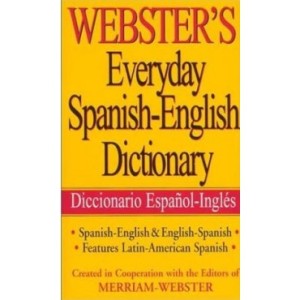
Spanish-English Dictionary
2. Keep an English/Spanish dictionary handy to use when you have a parent visiting or to give away to a parent or caregiver who needs it. It will show them that you’re making an effort to engage in their language of comfort, such as Webster’s Everyday Spanish-English Dictionary.

The Storyteller’s Candle
3. Learn about the children you serve and their heritage, and identify books that will affirm them. This Pura Belpré award winner is actually about Pura Belpré, the first Latina (Puerto Rican) to head a public library system: The Storyteller’s Candle.

Grandma and Me at the Flea
4. Share books that include some of the everyday experiences of the children and neighborhoods you serve, like this story highlighting the value of community and family: Grandma and Me at the Flea.

My Colors, My World
5. Bilingual books provide family members and caregivers the opportunity to read the same books their children are reading, but in their language of comfort. Families will love reading about all the colors of the rainbow in English and Spanish: My Colors My World.
Sign up with First Book to access these and other great titles on the First Book Marketplace.
Filed under:
Educator Resources,
ELL/ESL and Bilingual Books Tagged:
bilingual education,
dual language,
Educators,
ELA common core standards,
hispanic heritage,
Latino/Hispanic/Mexican,
parents,
Reading Aloud,
reading comprehension 

 Jill Eisenberg, our Resident Literacy Expert, began her career teaching English as a Foreign Language to second through sixth graders in Yilan, Taiwan as a Fulbright Fellow. She went on to become a literacy teacher for third grade in San Jose, CA as a Teach for America corps member. She is certified in Project Glad instruction to promote English language acquisition and academic achievement. In her column she offers teaching and literacy tips for educators.
Jill Eisenberg, our Resident Literacy Expert, began her career teaching English as a Foreign Language to second through sixth graders in Yilan, Taiwan as a Fulbright Fellow. She went on to become a literacy teacher for third grade in San Jose, CA as a Teach for America corps member. She is certified in Project Glad instruction to promote English language acquisition and academic achievement. In her column she offers teaching and literacy tips for educators.
What to do…what to do…If you are like us, the summer is an exciting time to discover new books, break out the art project we’ve been promising ourselves to start since February, and try every popsicle flavor from the ice cream truck.
Summer is the time to beat the heat, right? Whether that means hunting for air conditioning or jumping into a pool, we are here to keep you and your family loving books while you keep cool.
Over the coming weeks, we are pairing Lee & Low titles to your favorite summer destinations with fun activities!
Your summer outing: the ZOO
Book recommendation: Parrots Over Puerto Rico

Parrots Over Puerto Rico
Questions during reading:
- How have humans affected Puerto Rican parrots and Puerto Rico?
- What physical and behavioral adaptions help the Puerto Rican parrots survive in their environment?
- How do the scientists demonstrate persistence and creativity?
- What are the purpose and activities of the Puerto Rican Parrot Recovery Program?
- How has Puerto Rico changed over time?
- What does this book teach about sustainability?
- Do you think communities and governments should save endangered species? Why or why not?
Activities:
Recipe for Parrot Crackers!
Ingredients: avocado, lemon, raisins/dried cranberries, banana chips, round crackers

Parrot Crackers
- Peel half an avocado. In a small bowl, mash half the avocado with a fork until it is lump-free.
- Squeeze and mix in a little lemon juice into the mashed avocado to prevent it from turning brown.
- With a bread knife, spread the avocado over one side of each of the round crackers.
- Place two raisins or dried cranberries on top of the avocado side of each cracker for eyes.
- Cut or break a banana chip in half and place both below the eyes on the cracker to make the parrot’s beak. The two halves will stand off the cracker.
- Admire and eat!
Chef’s Note: We originally tried this with cream cheese and lime zest instead of avocado. We loved how the lime zest looked like real feathers and matched the collage work of illustrator, Susan L. Roth, but the lime zest had a wacky flavor so we went for the milder avocado!
Create a Food Web!
- Use Parrots Over Puerto Rico to make a list of all the plants and animals important to the Puerto Rican parrots existence in the book. The list should include: red-tailed hawks, humans, black rats, honeybees, Puerto Rican parrots, pearly-eyed thrashers, and sierra palm trees.
- Label which of these is a predator of, competitor to, and food source for the Puerto Rican parrot.
More resources for Parrots Over Puerto Rico:
Filed under:
Common Core State Standards,
Educator Resources,
Summer Tagged:
Reading Aloud,
reading comprehension,
recipes,
summer reading 


By:
jilleisenberg14,
on 6/21/2014
Blog:
The Open Book
(
Login to Add to MyJacketFlap)
JacketFlap tags:
Reading Aloud,
Educators,
reading comprehension,
close reading,
English Language Learners,
Educator Resources,
Common Core State Standards,
ELLs,
ELA common core standards,
ELL/ESL and Bilingual Books,
Add a tag
 Jill Eisenberg, our Resident Literacy Expert, began her career teaching English as a Foreign Language to second through sixth graders in Yilan, Taiwan as a Fulbright Fellow. She went on to become a literacy teacher for third grade in San Jose, CA as a Teach for America corps member. She is certified in Project Glad instruction to promote English language acquisition and academic achievement. In her column she offers teaching and literacy tips for educators.
Jill Eisenberg, our Resident Literacy Expert, began her career teaching English as a Foreign Language to second through sixth graders in Yilan, Taiwan as a Fulbright Fellow. She went on to become a literacy teacher for third grade in San Jose, CA as a Teach for America corps member. She is certified in Project Glad instruction to promote English language acquisition and academic achievement. In her column she offers teaching and literacy tips for educators.
The U.S. Department of Education’s Institute of Education Science (IES) and What Works Clearinghouse (WWC) released the latest educator’s guide to present best instructional practices for English Language Learners. Over the last several weeks, I’ve looked at several different strategies for teaching English Language Learners based on that guide’s recommendations.
Today, we’ll take a look at how to incorporate vocabulary instruction into activities that support listening, speaking, and writing practice for English Language Learners. This is the final week I will focus on the guide’s first recommendation: Teach a set of academic vocabulary words intensively across several days using a variety of instructional activities.

Drumbeat in Our Feet
Using the Lee & Low informational text, Drumbeat in Our Feet, as my model text, I applied the guide’s recommendations on how to choose an appropriate text and words for English Language Learners and how to teach the vocabulary over several days. See how I chose these words here and taught their meanings here.
Using Drumbeat in Our Feet and the IES’s process, my target words are origins, vital, ethnically, diverse, unique, vibrant and varied from the “Origins of African Dance” excerpt.
1. IES: Facilitate structured discussions to increase opportunities for students to talk about academic words. Always anchor these discussions around the topics that are present in the text and that do not have a clear-cut right or wrong answer. The goal is for students to learn to articulate a position or point of view and learn to defend their perspective or analysis. (P. 20)
Lee & Low: Over the course of multiple days, I am teaching a different part to each word’s meaning. After doing so, I want to create open-ended questions for whole or small group discussion that will allow my students to practice using the target words.
As my target words are origins, vital, ethnically, diverse, unique, vibrant and varied from the “Origins of African Dance” excerpt in Drumbeat In Our Feet, I would use these throughout the week for peer-to-peer discussion. This looks like:
- Why would the authors want to discuss the diverse land and countries of Africa in a book about African dance?
- Why might African dance vary in form?
- Why should we study the origins of African dance today?
- What factors might contribute to the diversity in African dance?
2. IES: Require students to use target words in their writing activities. (P. 21)
Lee & Low: Use the prompts above or focus on vocabulary-specific prompts. This looks like:
- What are the origins of your family?
- Write about the origins of a superhero.
- Create a story about the origins of the universe or how life began.
- Is it important to you to feel unique? Why or why not?
- What are at least two things vital to all life forms?
Although we cannot explicitly teach all academic and content-specific words our students will need to know in their educations and careers, we can be strategic in how we teach 5-8 words a week so they can apply these word strategies to new words they come across on their own.
Further reading on supporting English Language Learners in the classroom:
Filed under:
Common Core State Standards,
Educator Resources,
ELL/ESL and Bilingual Books Tagged:
close reading,
Educators,
ELA common core standards,
ELLs,
English Language Learners,
Reading Aloud,
reading comprehension 


By:
jilleisenberg14,
on 5/17/2014
Blog:
The Open Book
(
Login to Add to MyJacketFlap)
JacketFlap tags:
common core standards,
CCSS,
ELLs,
Curriculum Corner,
guided reading,
ELA common core standards,
Institute of Education Science,
middle school,
Reading Aloud,
elementary school,
vocabulary,
US Department of Education,
close reading,
English Language Learners,
Add a tag
 Jill Eisenberg, our Resident Literacy Expert, began her career teaching English as a Foreign Language to second through sixth graders in Yilan, Taiwan as a Fulbright Fellow. She went on to become a literacy teacher for third grade in San Jose, CA as a Teach for America corps member. She is certified in Project Glad instruction to promote English language acquisition and academic achievement. In her column she offers teaching and literacy tips for educators.
Jill Eisenberg, our Resident Literacy Expert, began her career teaching English as a Foreign Language to second through sixth graders in Yilan, Taiwan as a Fulbright Fellow. She went on to become a literacy teacher for third grade in San Jose, CA as a Teach for America corps member. She is certified in Project Glad instruction to promote English language acquisition and academic achievement. In her column she offers teaching and literacy tips for educators.
The U.S. Department of Education’s Institute of Education Science (IES) and What Works Clearinghouse (WWC) released the latest educator’s guide to present best instructional practices for English Language Learners.
Although we cannot explicitly teach all academic and content-specific words our students will need to know in their educations and careers, we can be strategic in how we teach 5-8 words a week so they can apply these word strategies to new words they come across on their own.
Last week I applied the guide’s recommendations on how to choose an appropriate text and vocabulary words for English Language Learners and I modeled it with the Lee & Low informational text, Drumbeat In Our Feet.
I will continue to focus on the guide’s first recommendation: Teach a set of academic vocabulary words intensively across several days using a variety of instructional activities.

Drumbeat In Our Feet
Using Drumbeat In Our Feet and the IES’s process, my target words are origins, vital, ethnically, diverse, unique, vibrant and varied from the “Origins of African Dance” excerpt in Drumbeat In Our Feet. See how I chose these words here.
1. Read the text
IES: Introduce the topic of the text by asking about students understanding of the topic and personal experiences. Read the excerpt aloud at the start of the lesson. (P. 24)
Lee & Low: I would read the text aloud so students who cannot comprehend the text independently can access the text whole group. All students should be able to follow along with their own student copy. Only constant interaction with the print and following along will allow students to connect with what I am saying and how I say it with what they are seeing in the print.
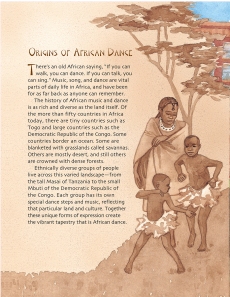
“Origins of African Dance,” excerpt from Drumbeat In Our Feet
2. Introduce the vocabulary
IES: After reading the text and stopping to ask clarifying questions, introduce the target vocabulary words and have students find the words (in their copies). Display a list of the words in the classroom. (P. 24)
3. Teach the vocabulary words in layers
IES: “Teach academic vocabulary in depth using multiple modalities (writing, speaking, listening)” and “teach word-learning strategies to help students independently figure out the meaning of words.” (P. 18-22)
Lee & Low: Over the course of 5-8 days (lesson periods), I would focus on a couple of aspects of each of the new vocabulary words. On a whole class chart where the target words are listed, I would add a new component to each word each day in order to deepen the meaning and foster familiarity with the words for students.
Together we will create a student-friendly definition; write synonyms, antonyms, examples, non-examples; determine parts of speech; draw a picture or create an action/gesture to represent the words; list related word forms and any cognates; break the word down into word parts; and use the word in a meaningful, student-generated sentence.
For example, Monday I would read the excerpt, introduce the target words, find the target words in the text, and come up with a definition for each target word. Tuesday, I would revisit the chart and add synonyms, antonyms, examples, and non-examples for all the vocabulary words to reinforce meaning. Wednesday I would cover part of speech and concrete representations, and so on.
Below is how I would teach my target word, origins, from Drumbeat In Our Feet but I would cover all of the target words each day.
Monday
- student-friendly definition: the source where something starts
Tuesday
- synonyms: beginnings, birthplace, roots, foundation
- antonyms: end, destination, result
- examples: beginning of the universe and life, family backgrounds/heritage, word roots, superhero/comic book origin stories
- non-examples: death of a star, the youngest person in the family tree, the last book in a comic book series
Wednesday
- part of speech: noun
- draw a picture to represent the word: I might draw a lake with a river leading up to a mountain and arrow pointing to where the river starts.
- create an action/gesture to represent the word: with my left hand held out at hip-level as the “lake,” I would point with my right finger to my left shoulder (the mountain) as the origin of the river. [Tip: Students are great at brainstorming concrete representations of words!]
Thursday
- list related word forms: original, originate
- list any cognates: origine (French), origen (Spanish)
Friday
- affixes: none
- use the word in a meaningful, student-generated sentence: We hiked from the lake up to the mountain looking for the origins of the river. The original owner of this house built this house all on her own in 1956.
Remember: This is a process I will repeat each week or every 5-8 lessons with a new text and set of target words. While my students may know only up to 400 new vocabulary words by the end of the year, this repeated process will allow them to tackle new vocabulary words in other content classes and in independent reading.
Next week, we will take a look at how to incorporate the selected vocabulary into activities that support listening, speaking, and writing practice for English Language Learners.
Further reading on supporting English Language Learners in the classroom:
Filed under:
Curriculum Corner Tagged:
CCSS,
close reading,
common core standards,
ELA common core standards,
elementary school,
ELLs,
English Language Learners,
guided reading,
Institute of Education Science,
middle school,
Reading Aloud,
US Department of Education,
vocabulary 


By:
Hannah,
on 4/12/2014
Blog:
The Open Book
(
Login to Add to MyJacketFlap)
JacketFlap tags:
Latino/Hispanic/Mexican,
Día de los niños/Día de los libros,
Curriculum Corner,
English-Spanish,
libros en Español,
Reading Aloud,
parents,
bilingual books,
Read Aloud,
guest blogger,
ell,
bilingual,
teaching resources,
bilingual education,
reading comprehension,
Add a tag

Jennifer Brunk has been teaching Spanish and English learners from preschool to university level for over 20 years. She re sides in Wisconsin where she raised her three children speaking Spanish and English. Jennifer blogs about resources for teaching Spanish to children on Spanish Playground. The following post is reprinted with permission from her original post at Spanish Playground.
sides in Wisconsin where she raised her three children speaking Spanish and English. Jennifer blogs about resources for teaching Spanish to children on Spanish Playground. The following post is reprinted with permission from her original post at Spanish Playground.
Research has shown that reading to children helps them learn vocabulary and improves listening comprehension skills. As a parent or teacher, you are probably convinced of the value of reading to your child in Spanish, but how should you do it to promote language development?
First, it is important to keep in mind that above all reading should be enjoyable. We want to create positive associations with reading in any language. So, use these strategies and add plenty of silliness, snuggling, or whatever makes your child smile.
1. Identify core vocabulary in the story. If there are words that are central to the story that your child does not know, teach them first or make them clear as you read by pointing to the illustrations or using objects.
2. Use illustrations, objects, gestures and facial expressions to help kids understand new words. Choose stories with a limited number of new vocabulary words and a close text-to-picture correspondence.
3. Simplify the story if necessary. It is fine to reword or skip words or sentences. As your child becomes familiar with the story and acquires more vocabulary, you can include new language.
4. Read slowly. Children need time to process the sounds, connect them with the illustrations and form their own mental images.
5. Pronounce words as correctly as possible. To develop listening comprehension skills and learn new vocabulary, children need to hear correct pronunciation and natural rhythm. If your Spanish pronunciation is a work in progress, take advantage of technology. Look for books with audio CDs and ask a native speaker to record stories. At first, listen to the story with your child and take over reading when you are confident of the pronunciation.
6. Engage your child with the story by providing different ways for her to participate.Ask questions that can be answered by pointing or say a repeated phrase together. You can also give your child a toy or object that she can hold up each time she hears a key word.
7. Read the same story over and over. Repetition is essential to language learning.
8. Relate the story to your child’s life by drawing parallels as you read: Tiene un perro. Nosotros también tenemos un perro. As you go about your daily routines, refer to stories you have read.
9. Use puppets or figures to act out stories when you are playing with your child. Dramatizing the story adds movement to enhance learning and provides essential repetition of the language in context.
10. Do activities that expand on the language in the book. Look for songs, crafts or games with related vocabulary and structures.
 Visit Spanish Playground for more great resources for teaching Spanish to children, and don’t forget that Dia de los niños/ Día de los libros is in just a few weeks! What are you doing to celebrate? What are your favorite books in Spanish to read aloud?
Visit Spanish Playground for more great resources for teaching Spanish to children, and don’t forget that Dia de los niños/ Día de los libros is in just a few weeks! What are you doing to celebrate? What are your favorite books in Spanish to read aloud?
Filed under:
Curriculum Corner,
guest blogger Tagged:
bilingual,
bilingual books,
bilingual education,
Día de los niños/Día de los libros,
ell,
English-Spanish,
Latino/Hispanic/Mexican,
libros en Español,
parents,
Read Aloud,
Reading Aloud,
reading comprehension,
teaching resources 

My Baby Bookworm is not such a baby anymore. She turned four this weekend (with much celebration, and many cupcakes). So far, our efforts to ensure that she loves books seem to be paying off. Here are a few recent tidbits.

 We were very nearly late for her birthday party (which we held out at her gymnastics place), because she wanted me to read her "just one more" Little Critter book. We incidentally let each child select a book as a party favor. The Fancy Nancy books were the most popular.
We were very nearly late for her birthday party (which we held out at her gymnastics place), because she wanted me to read her "just one more" Little Critter book. We incidentally let each child select a book as a party favor. The Fancy Nancy books were the most popular.

 She had to stop in the middle of opening presents to ask Daddy to read her the newly unwrapped Mo Willems book (The Pigeon Needs a Bath). Yes, I did get that on video. When things do not go her way, she says: "Hmmpf." She does not seem to realize that she picked this up from the Pigeon. But we do.
She had to stop in the middle of opening presents to ask Daddy to read her the newly unwrapped Mo Willems book (The Pigeon Needs a Bath). Yes, I did get that on video. When things do not go her way, she says: "Hmmpf." She does not seem to realize that she picked this up from the Pigeon. But we do.
She has started using words like "mischievous" when describing the behavior of her dolls . She doesn't always use big words correctly, but she is clearly trying.
As for me, I find it rewarding (if occasionally inconvenient) that she requests to have books read aloud at all hours of the day. We've also learned that when she becomes particularly insistent about us reading to her around dinnertime, it means that she is extra-tired. She wants to get her books in before she falls asleep. Because that's what bookworms, whether babies or not, do.
© 2014 by Jennifer Robinson of Jen Robinson's Book Page. All rights reserved. You can also follow me @JensBookPage or at my Growing Bookworms page on Facebook. This site is an Amazon affiliate.


By:
jilleisenberg14,
on 4/8/2014
Blog:
The Open Book
(
Login to Add to MyJacketFlap)
JacketFlap tags:
children's books,
diversity,
Reading Aloud,
geography,
Educators,
environmentalism,
reading comprehension,
close reading,
Multiracial,
common core standards,
CCSS,
Curriculum Corner,
guided reading,
ELA common core standards,
geoliteracy,
vanishing cultures,
Add a tag
Jill Eisenberg, our Resident Literacy Expert, began her career teaching English as a Foreign Language to second through sixth graders in Yilan, Taiwan as a Fulbright Fellow. She went on to become a literacy teacher for third grade in San Jose, CA as a Teach for America corps member. She is certified in Project Glad instruction to promote English language acquisition and academic achievement. In her column she offers teaching and literacy tips for educators.
Eisenberg, our Resident Literacy Expert, began her career teaching English as a Foreign Language to second through sixth graders in Yilan, Taiwan as a Fulbright Fellow. She went on to become a literacy teacher for third grade in San Jose, CA as a Teach for America corps member. She is certified in Project Glad instruction to promote English language acquisition and academic achievement. In her column she offers teaching and literacy tips for educators.

Vanishing Cultures: Mongolia
Last week on the blog we spotlighted the work of Jan Reynolds, an author and explorer who has written nonfiction for young readers about cultures across the globe. If we had read the Vanishing Cultures series when I was a classroom teacher, my students would have been competing with each other over who knew the most outrageous fact. Did you know the Tiwi, an aboriginal tribe from an island off the coast of Australia, eat mangrove worms fresh? Did you know the Inuit from the Hudson Bay build rock piles that are stacked to look like men in order to scare caribou toward the real Inuit hunters?
My students loved to play the “did you know…” game. That became a popular sentence starter in our classroom. Students would scramble for the latest book or periodical on animals, prehistoric times, and exotic locales. The peregrine falcon, megalodon, and the giant panda were unshakable favorites.
Yet, we don’t want students to know “just facts” as if they are mini-encyclopedias. We aspire for our students to wonder and to investigate how our world works, how we are all connected to our environment and other humans halfway around the globe, and how our actions here affect others way over there.
The Common Core brings a refreshed spotlight to the nonfiction genre in children’s books, challenging publishers, educators, librarians, and parents to present children with high interest, high quality texts. What a time to engage students’ senses, sustain their wonder, and teach them geo-literacy!
National Geographic affirms, “with the rapid pace of change in the 21st century, it is more important than ever that young people understand the world around them.” It has adopted the concept of “geo-literacy,” and even gone so far as to create a community to support and cultivate “geo-educators.”

Vanishing Cultures: Himalaya
Enjoyed in classrooms around the nation, Jan Reynolds’ collection on at-risk traditional cultures is even more significant and striking today than when the series was first published. The persistent popularity of the Vanishing Cultures series speaks to its captivating power to make geo-literacy learning personal and tangible. This collection supports geo-literacy learning because each book challenges students to examine:
- the characteristics of each culture
- what makes this featured culture unique
- how this group of people has adapted to survive in its environment
- what challenges this group of people faces
- the modern human impact (positive and negative) on this traditional culture and the environment
- why the author would want to share this story with children and create a whole series on this topic
When we educate children about other cultures and geo-literacy more broadly, we are implanting the idea that we learn in order to make better, more informed decisions. Before our students become adults in positions of power, we want them to have practice in pausing and thinking how their choices to construct their community could disturb the environment of another community or animal species.
The Vanishing Cultures books encourage students to reason and reflect critically and deeply about how humans affect other humans and why we all benefit from diversity. As classrooms around the country can attest, Jan Reynolds’ books will not only spark enthusiasm that we hope ignites into lifelong careers and hobbies, but also conversation on what information we need to make decisions that will shape our and others’ health, environment, and well-being.

Vanishing Cultures: Down Under
Classroom Ideas for Comparing and Contrasting Between Vanishing Cultures Books and Teaching Geo-Literacy
(Reading Standards, Integration of Knowledge & Ideas, Strand 9)
(Writing Standards, Research to Build & Present Knowledge, Strand 7 and 9)
- How are these cultures similar and different from each other? What actions do these families take in both books to protect their ways of life?
- Compare how the challenges of each culture are similar or different.
- Compare how the children in each book demonstrate their pride in their culture. Why is it important for the children to feel proud of who they are and their way of life?
- What is the author’s purpose in starting each book with the parents telling their child a story from long ago? How does this affect the tone of and set the mood in the series? How does this opening support the central idea?
- After reading two or more of the Vanishing Cultures books, what common features or characteristics does a Vanishing Culture book have? If you were to write a book about your family’s culture, what kinds of things happen in a Vanishing Cultures book? What are some things that will not happen in a Vanishing Cultures book? What central ideas and lessons will be in the book?
- Have students create a chart to compare different aspects of life across two or more cultures. Write the name of each cultural group being compared on the top of the chart, and list the topics for points of comparison down the left side. Here are some possible topics: Food, Clothing, Climate, Geography, Important Animals, Homes, How Children Help (Chores), Roles of Men & Women, Family Life, How People Have Fun, Beliefs, Means of Transportation, Challenges Faced Today, Celebrations, Honoring Loved Ones. Have students record appropriate information as they read and re-read the texts.
- One elementary class created the “Around the World with Jan Reynolds” project on Google Earth. Explore where each of the books takes place. Compare the political map with the satellite map. Reflect on how geography has helped or hurt the survival of these ancient cultures. Students can create their own maps of the different cultures at National Geographic’s MapMaker’s 1-Page Maps.
Filed under:
Curriculum Corner Tagged:
CCSS,
children's books,
close reading,
common core standards,
diversity,
Educators,
ELA common core standards,
environmentalism,
geography,
geoliteracy,
guided reading,
Multiracial,
Reading Aloud,
reading comprehension,
vanishing cultures 


By:
jilleisenberg14,
on 3/29/2014
Blog:
The Open Book
(
Login to Add to MyJacketFlap)
JacketFlap tags:
biographies,
lesson plans,
Educators,
environmentalism,
reading comprehension,
Wangari Maathai,
African/African American Interest,
common core standards,
CCSS,
Curriculum Corner,
ELA common core standards,
ReadyGEN,
children's books,
holidays,
History,
diversity,
Reading Aloud,
Add a tag
 Jill Eisenberg, our Resident Literacy Expert, began her career teaching English as a Foreign Language to second through sixth graders in Yilan, Taiwan as a Fulbright Fellow. She went on to become a literacy teacher for third grade in San Jose, CA as a Teach for America corps member. She is certified in Project Glad instruction to promote English language acquisition and academic achievement. In her column she offers teaching and literacy tips for educators.
Jill Eisenberg, our Resident Literacy Expert, began her career teaching English as a Foreign Language to second through sixth graders in Yilan, Taiwan as a Fulbright Fellow. She went on to become a literacy teacher for third grade in San Jose, CA as a Teach for America corps member. She is certified in Project Glad instruction to promote English language acquisition and academic achievement. In her column she offers teaching and literacy tips for educators.
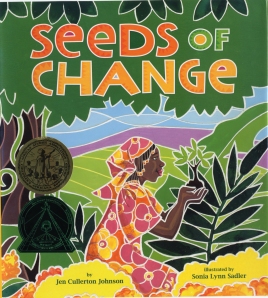
Seeds Of Change
In honor of Wangari Maathai’s birthday on Tuesday, April 1 and upcoming Earth Day later this month, we at Lee & Low Books want to share all the fantastic resources and ideas that are available to educators who are teaching about Wangari Maathai’s legacy and using Seeds Of Change: Planting a Path to Peace.

Seeds Of Change
Elementary School:
 Middle School and High School:
Middle School and High School:
- Seeds Of Change won the American Library Association’s Coretta Scott King/John Steptoe Award for New Talent in Illustration in 2011. The Committee Chair and Book Jury have prepared activities and discussion questions for Seeds Of Change in the 2011 Discussion Guide for Coretta Scott King Book Awards, P. 20-21.
- Have students read and discuss author Jen Cullerton Johnson and illustrator Sonia Lynn Sadler’s joint interview with Lee & Low, which covers the environment, their travels, and Wangari Maathai’s achievements.
- After introducing Wangari Maathai with Seeds Of Change, delve deeper with the Speak Truth To Power human rights education curriculum, a project of the Robert F. Kennedy Center for Justice and Human Rights. They present an in-depth exploration on Wangari Maathai, the Green Belt Movement, and sustainability issues.
- In teaching standard 7 of the ELA Common Core, have students evaluate how Wangari Maathai is presented in a documentary compared to the Seeds Of Change biography. PBS’s documentary on Wangari Maathai and the Green Belt Movement, Taking Root: The Vision of Wangari Maathai, contains a classroom section full of video modules, handouts, and lesson plans.
What did we miss? Let us know how you are using Seeds Of Change in your classroom!
Filed under:
Curriculum Corner Tagged:
African/African American Interest,
biographies,
CCSS,
children's books,
common core standards,
diversity,
Educators,
ELA common core standards,
environmentalism,
History,
holidays,
lesson plans,
Reading Aloud,
reading comprehension,
ReadyGEN,
Wangari Maathai 

La Palabra Hosts Bloguera Xánath Caraza, Shy But Flyy, and Debuts Eric "Praxis" Contreras
It was Karineh Mahdessian's second time at the helm of the monthly reading series, La Palabra, at Northeast Los Angeles' Avenue 50 Studio.
She hit her stride. Unfazed by a featured reader's late arrival and Xánath Caraza's time-certain departure an hour after the 2:00 opening, Karineh improvised with aplomb.
Mahdessian altered the series' pattern of Open Mic and Featured Reader. In this instance, Open Mic launched the afternoon, the Featured readers came next, another Open Mic, and an engaging Q&A followed.
Bloguera Xánath Caraza's reading included work from Conjuro, including the heart-thumping
Yanga that had the audience dancing in their seats to the intoxicating rhythm of the Afro-Latino influenced text.
A special moment in the reading. Caraza's latest collection, Noche de Colibríes: Ekphrastic Poems, features cover art by Heriberto Luna. Caraza had not met the artist, whose studio is in the Avenue 50 complex. Luna joined the audience for Caraza's reading of Luna's poem.
Madhessian holds Luna's Tree of Life painting featuring the cosmic hummingbirds of the cover as Xánath reads the piece inspired by the painting. After, Luna tells me he enjoyed the heck out of the experience.
Southeast Los Angeles' Eric "Praxis" Contreras made his featured poet debut at La Palabra, his name had never been on a poster. Mahdessian disclosed that Contreras will soon be a household name when a feature LATimes article appears.
Contreras writes feminist poetry, sharing a powerfully constructed piece in the voice of a woman. He tells the audience his grandmother and mother are the dominant influences in his life, and he rejects the attitudes of some pendejos who don't understand nor value women.
Eric's motivations for poetry extend from the personal to the community. His home city of Bell is notorious for government corruption, but also for its dramatic absence of a cultural life.
Contreras works to fill the void by holding
Alivo Open Mics in his garage.
Alivio brings in a crowd of young adults and neighborhood viejitos to share their own, or hear others' poetry.
It's those crowds of gente coming to some vato's garage to do a floricanto that brings the LA Times' Ruben Vives (who broke the Bell corruption scandal story) to shadow the high school substitute teacher for the feature.
In addition to
Alivio, Contreras hosts a biweekly reading at
Corazón y Miel Restaurant in Bell.
Find information on the Alivo series and Corazón y Miel, via
Eric's Facebook page, don't wait for the LA
Times article.
If she's shy she holds it back and lets loose with a frenetic array of musical poetry that led an already exhausted audience to higher levels of energy and joyousness.
Shy But Flyy's harmonious blend of spoken word, song, and drumming provided La Palabra's house with a stirring example of poetry out loud y con ganas.
Shy But Flyy organizes poetry readings from her Long Beach area residence. La Bloga looks forward to learning and sharing more about these events at the far southeast of LA County.
Open Mic at La Palabra
A sense of community and carnalismo develops among the gente attending a La Palabra meeting. Much of this grows from the Open Mic. Open means anyone, from a trembling novice reading their stuff to an audience for the first time, or experience veterans like Jessica Ceballos and Luivette Resto, or Joe Kennedy. I'd not heard Charlie Zero, lower right, read before.
For the most part, today's readers omitted the most valued element of a reader's nonverbal communication--eye contact. It's a problem of handling the manuscript, but also of lack of confidence.
Here are Flor de Té, Angel Garcia, Karla Sanchez, and William A. Gonzalez. Two got stuck to their manuscripts while Angel and Karla had a bit of eye contact.
Rebekkah Bax read her selection from Mahdessian's
Heartbreak Anthology. When a piece is quite short, the reader should allow herself a slow pace to avoid the
look down look up and she's gone effect. It stymies photographers.
Karineh handled the Q&A effectively. The loquacious audience had lots of questions and the two featured readers elaborated effectively on their answers. Shy But Flyy hedged her story about her earliest writing performance. Her mother spills the beans in the lower right foto, telling how the precocious three-year old demanded an audience for her compositions. That patience worked, Ma, the kid is a wonderful performer.
Reading Your Own Stuff challenges every writer from the laureates to the rookies. See the
"Reading Your Stuff Aloud" pages at Read! Raza for tips on eye contact, handling manuscripts, delivery, and memorization.
Here's a link to individual portraits.Twenty Little Helpless Souls
La Bloga friend Edward Vidaurre is one of four editors of a sadly needful collection of poems. Twenty honors the twenty treasures who were shot by a man armed with a rifle and a broken mind. The babies were six, and seven, years old.
Nothing like this should happen, ever. Yet, the December 2012 shootings in Newton CT stand in a long line of United States cultural markers outsiders can point to and say, “that is ‘American’ culture” and they mean you.
It’s a rhetorical situation that calls for poetry. That perception of who we are demands a counterstatement as loudly heard as bullets. Twenty: In Memoriam is counterstatement, fifty-five poets stepping forward in communal expression of who we are. Photography and art embellish the collection. Many of the poets, like Vidaurre, are from the Rio Grande Valley. Poets Laureate Juan Felipe Herrera and Carmen Tafolla contribute, as well as several La Bloga friends and On-line Floricanto poets, including Nancy Aidé Gonzalez, Iris de Anda, and Claudia D. Hernandez. Hernandez’ fotos are a notable bonus to the book.
In his “Introduction Writing Kindness,” Juan Felipe Herrera tells us, “These poems speak wisdom. It is hard to find it – perhaps you must fall into each other, bathe in the palms of intertwined hands ripped by shrapnel and sense the sublime there, flowering, in those wounds.”
Editor José Chapa V recalls, “When I was approached with the offer to help curate TWENTY, I had mixed feelings. We knew that on one hand, the poems would seek to commemorate and honor the victims of the tragic shooting, and that on the other they would be probing darker areas than the usual poetry anthology. I wasn’t sure how to go about it, if the work that arrived (regardless of quality) would fit such delicate criteria, and what kind of response our gesture would gather. But I decided to join the editorial team on the knowledge that such events have an impact not just on the victims and their families, not just on our nation, but on the entire human species.”
Editor Vidaurre explains a powerful feature of the collection.
Twenty-eight lives were lost. This book is dedicated to the educators that lost their lives as well. Page 20 in this anthology is left blank, purposefully: we ask that when you come across it, you say a special prayer, close it for a bit and reflect, write your thoughts, a poem, a song, or bring the book to your chest and hold it.
The book comes from McAllen, Texas and El Zarape Press. The collection presently has distribution only from Amazon, though the press promises alternative distribution in future. Use ISBN-13: 978-1494326753 or ISBN-10: 1494326752 with your local bookseller to order. Some money from sales will go to charities serving children.
Más Tequila Review Hits the StreetsThat’s old newspaper talk for a new edition. Unlike the newspapers or yore, a new edition of an independent poetry journal like
The Más Tequila Review doesn’t have streetcorner urchins shouting “TMTR, get yer TMTR” on every block.
Headquartered in Alburquerque, New Mexico,
The Más Tequila Review is the love child of Richard Vargas and the muses of poetry. The current issue, Vargas confesses, has a new look because he accepted too many poets to fit the normal press run. Euterpe and Erato were whispering in Vargas' ears as he's featuring Jazz Poetry in the issue.
For information on ordering the $7.00 collection—I proofed this copy, the price is seven U.S. dollars--
click here for the Facebook TMTR page, and
here for the TMTR website.Free La Tolteca ‘Zine In its fifth year, La Tolteca ‘Zine sets itself up as a sassy, thoughtful resource for razacentric writing with an actitude, or make that a twist.
In 2012, La Tolteca promised its December issue would be “more exciting, original thought, images & literature to boggle your mind, put a jiggle in your wiggle & bring you closer to the gods. Strap on your seat belt or something & subscribe. It’s the only thing you’ll get this season for free + our love.” A year later, staff was telling readers, “Subscribe now! It’s free! Pass on to your high falutin’ thinker friends, poet acquaintances and barely literate family members who like the arts. There’s something for (almost) everyone, who thinks, supports the arts and occasionally still reads. Happy holidays with love from la tolteca staff.”
It’s free.
Getting there is half the fun.
Click on this Facebook link to learn more about the process.
The ‘Zine marks one of those labors of love that busy people take on because they have to. As if she didn’t have her hands full writing and workshopping writers and living her life, Ana Castillo is la éminence grise of La Tolteca.
La Tolteca arrives on your desktop as a deluxe interactive graphic with the look and feel of a print magazine. There's a special bonus for gente who've joined one of Ana Castillo's workshops. Some get to work on the 'Zine, plus the 'Zine runs contests open to workshopistas.
Latinopia Scrolls |
| Six-column layout is easy-to-read. Magnifying or shrinking your browser window gives fewer or more columns. |
One of my favorite Chicana Chicano media sites is
Latinopia. It’s a visionary place that keeps growing.
Film maker Jesus Treviño shares his enormous video library in multiple small portions. He updates the site weekly. One week he might have José Montoya reading “El Louie,” another week he will share a few minutes from a documentary spotlight on ASCO. And each week there will be six other highlights just like those.
Latinopia shows contemporary as well as historic video. Treviño regularly captures community events—see RudyG’s
reading--plus conducts interviews with a variety of people from artists like Sonia Romero or Linda Vallejo to performances by Ruben Guevara or Conjunto Aztlán. Book reviews, Serge Hernandez’ resurrected Arnie and Porfi cartoon that originated in Con Safos Magazine, and the Zombie Mex Diaries, make regular appearances.
Treviño’s staff make regular improvements and adaptations to the site. The site encourages visitors to scroll through newspaper-like columns dotted with descriptive and promotional links to features in art, literature, history, food, music, theatre, film, art, and blogs. Fotos mark divisions between stories so individual items are easily discerned. Ample white space further defines links to stories and videos.
Visit Latinopia with ample time. Once a visitor begins scrolling those columns and discovering the richness of cultura and history here, they’ll become lost in the delights of this space.
On-line Floricanto: Blackjack PoemsPamela Murray Winters, David Taylor Nielsen
La Bloga friend Maritza Rivera invented a 21st century poetic form, the Blackjack Poem. Comprised of three lines, 7 syllables each, for a jackpot of 21 syllables, the form produces delightfully playful, often pithy, pieces.
Learn more about Blackjack poetry, submit your own, via the
Blackjack Poets Facebook page.3 Blackjacks By David Taylor NielsenWhen Batman kissed Superman,
A kryptonite explosion
Left Kal-El weak in the knees.
ADHD poetry:
I would explain it to you,
But I've moved on already.
Who needs a thousand foreskins?
Samson, I don't understand.
Wasn't killing them enough?
David Taylor Nielsen is a Literacy Coach and reading teacher with Montgomery County Public Schools. He is currently the host of Poetry Night Open Mic in Greenbelt, MD. He can also be found haunting other open mic poetry readings in the DC Metro Region. He has been published in Gargoyle Magazine and Three Line Poetry.
Three Blackjacks from the Pantry By Pamela Murray WintersJicamaBorn to be architecture:
firm mild wallboard disguised as
an expensive vegetable.
Garlic ScapesBraid and swing from their fresh stink,
stir-fry your fantasies with
these perfumed limbs of Chthulu.
TurmericLast night I rolled in you and
inhaled your distinct attar.
Morning: the gold won’t wash off.
A native of Takoma Park, Maryland, Pamela Murray Winters now lives on the Western Shore of the Chesapeake Bay with her husband and animals, most of them poets.
 Jill Eisenberg, our Resident Literacy Expert, began her career teaching English as a Foreign Language to second through sixth graders in Yilan, Taiwan as a Fulbright Fellow. She went on to become a literacy teacher for third grade in San Jose, CA as a Teach for America corps member. She is certified in Project Glad instruction to promote English language acquisition and academic achievement. In her column she offers teaching and literacy tips for educators.
Jill Eisenberg, our Resident Literacy Expert, began her career teaching English as a Foreign Language to second through sixth graders in Yilan, Taiwan as a Fulbright Fellow. She went on to become a literacy teacher for third grade in San Jose, CA as a Teach for America corps member. She is certified in Project Glad instruction to promote English language acquisition and academic achievement. In her column she offers teaching and literacy tips for educators.
Dissecting excerpts, highlighting evidence, defending one’s answer choice, bubbling in exit slips. As necessary as all that preparation for upcoming state assessments may be, March and April for teachers and students can be arduous. In some cases, students are learning how to take a test for the first time. For many, the third quarter risks turning enthusiastic momentum for reading, developing interests, and taking academic risks into a trudge of review and re-teaching.
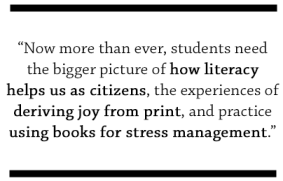 With all this reading in overdrive, it is understandable that few students (and teachers) want to keep reading at home for pleasure. Yet we need to sustain student excitement for reading and prevent testing anxiety. Now more than ever, students need the bigger picture of how literacy helps us as citizens, the experiences of deriving joy from print, and practice using books for stress management.
With all this reading in overdrive, it is understandable that few students (and teachers) want to keep reading at home for pleasure. Yet we need to sustain student excitement for reading and prevent testing anxiety. Now more than ever, students need the bigger picture of how literacy helps us as citizens, the experiences of deriving joy from print, and practice using books for stress management.

Where On Earth Is My Bagel?
If you have observed your students retreating from the idea that books are an escape and hobby to an unpleasant, stressful task, here are some techniques to increase the joy factor in reading and keep kids hooked:
- After lunch, recess, or the morning message, bring the class together to listen to you read a poem or a chapter from a longer book that is not connected to a skills or strategies lesson. This daily activity exposes students to books beyond their reading levels, bolsters classroom community in an otherwise competitive time, and communicates that books have calming, revitalizing effects.
- Continue to highlight books with relevant holidays, core value themes, or S.T.E.M. content using designated bins or book cover displays at child height. Even during crunch time when it is hard to infuse lessons with interdisciplinary connections and core value applications, these exhibitions or quick booktalks allow students to explore and develop their interests. Consider creating collections for Women’s History Month, Cesar Chavez Day, baseball season, National Poetry Month in April, and Earth Day.
- Lead students with books in arms to another classroom or outside for a “field trip.” This physical change of scenery reinforces that books are a mental change of scenery and a respite.
- Set aside 20 minutes every day just for independent reading instead of squeezing in one more skills mini-lesson. Preserving time for students to interact with books of their choice in independent reading allows students to take a break, manage tension, and re-focus their energy. During this time, students self-select books they enjoy, exercise literacy strategies, and feel in control of their learning. This commitment and preservation of independent reading time conveys to students how seriously you value and respect this sacred time to enjoy a book.

Ten Oni Drummers
- A lot of test preparation and review involves independent work and sitting quietly. For an end of the week reward, let students choose a classroom peer to read to instead of independent reading that day, invite a younger grade to your classroom for your students to read to, utilize siblings and family relationships at the school, or invite other stakeholders in your students’ educations (like the cafeteria or main office staff) to enjoy a book with students. Reading to someone (buddy reading) allows scholars a chance to talk, enjoy a book in a low-stakes environment, and escape to a new world in a wonderful story.
- Encourage parents to lead a whole-class read aloud in the classroom. This time gives you a chance to conference with struggling readers, celebrate parents as teachers, and encourage the intergenerational fellowship of books.
- Invite an author to school or hold an online interview . There is nothing quite like reinvigorating young readers and writers than with a real author. This bright treat gives students a badly needed broader perspective of books beyond assessments. For more information on how to bring authors into your unit of study no matter what your budget is, check out this post.
- Change up the routine! Have an “opposites day” in which two teachers switch for a read aloud/poem one day. Or engage other school community members (like the principal, school nurse, and other non-teaching staff) to read to the whole class so that your students can see that they have a whole team cheering for them and invested in their growth, health, and success.
Do your students need a distraction? These joyful books offer just enough silliness, escape, or suspense to remind students that books are also for entertainment!
Filed under:
Curriculum Corner Tagged:
CCSS,
children's books,
Reading Aloud,
reading comprehension 


By:
Jen Robinson,
on 3/12/2014
Blog:
Jen Robinson
(
Login to Add to MyJacketFlap)
JacketFlap tags:
baby bookworm,
growing bookworms,
children's books,
book reviews,
young adult books,
Mo Willems,
picture books,
reading aloud,
Newsletter,
Add a tag
 Today I will be sending out a new issue of the Growing Bookworms email newsletter. (If you would like to subscribe, you can find a sign-up form here.) The Growing Bookworms newsletter contains content from my blog focused on children's and young adult books and raising readers. I currently send out the newsletter once every two weeks.
Today I will be sending out a new issue of the Growing Bookworms email newsletter. (If you would like to subscribe, you can find a sign-up form here.) The Growing Bookworms newsletter contains content from my blog focused on children's and young adult books and raising readers. I currently send out the newsletter once every two weeks.
 Newsletter Update: In this issue I have four book reviews (picture book through young adult), as well as post about my daughter's latest literacy milestone, and one about why I think she loves Mo Willems' books so much. I have two posts with links that I shared on Twitter recently.
Newsletter Update: In this issue I have four book reviews (picture book through young adult), as well as post about my daughter's latest literacy milestone, and one about why I think she loves Mo Willems' books so much. I have two posts with links that I shared on Twitter recently.
Reading Update: In the last two weeks I read one middle grade book, three young adult books, and one adult title:
- Jaleigh Johnson: The Mark of the Dragonfly. Random House Books for Young Readers. Middle Grade/Middle School. Completed March 11, 2014, on Kindle. Review to come.
- Mark Frost: Alliance (The Paladin Prophecy, Book 2). Random House Books for Young Readers. Young Adult. Completed March 3, 2014. My review.
- Jennifer E. Smith: The Geography of You and Me. Poppy (Little, Brown Books for Young Readers). Young Adult. Completed March 4, 2014, e-ARC on Kindle. Review to come.
- Lauren Henderson: Kissing in Italian. Random House Books for Young Readers. Young Adult. Completed March 9, 2014. Review to come.
- Robin Sloan: Mr. Penumbra's 24-Hour Bookstore. Picador. Adult Fiction. Completed February 26, 2014, on Kindle. I quite enjoyed this book about everything from musty old books and secret societies to data visualization and Google. It's a fast read, sure to please most adult book lovers.

 I'm currently reading Insignia by S. J. Kincaid on my Kindle and The Spy Catchers of Maple Hill by Megan Frazer in print. I am very much enjoying my current audiobook, A Week in Winter by Maeve Binchy. It is the perfect antidote to stress, and I wish it would never end.
I'm currently reading Insignia by S. J. Kincaid on my Kindle and The Spy Catchers of Maple Hill by Megan Frazer in print. I am very much enjoying my current audiobook, A Week in Winter by Maeve Binchy. It is the perfect antidote to stress, and I wish it would never end.
We're also still reading to Baby Bookworm these days, of course. You can check out the complete list of books we've read to her this year if you are interested. We also read the first two chapters of Winnie-the-Pooh last night.
She turns four in a few weeks, and I can tell you that we're really seeing the impact of all the books that we've read. She can spell a few words now (her name, Mom, Dad, no, moo, Mo, so), and she'll notice those words if she sees them ("Why does that sign say 'No'?). She's asking how to spell things like "I love you" when she makes us cards. She enjoys the Reading Raven app. I can't remember who recommended that one, but thank you! We are careful not to push her, but she's like a little sponge these days, soaking up new words all around her. My goal is just to keep it fun!
What are you and your family reading these days? Thanks for reading the newsletter, and for growing bookworms.
© 2014 by Jennifer Robinson of Jen Robinson's Book Page. All rights reserved. You can also follow me @JensBookPage or at my Growing Bookworms page on Facebook.

View Next 25 Posts

 Jill Eisenberg, our Senior Literacy Expert, began her career teaching English as a Foreign Language to second through sixth graders in Yilan, Taiwan as a Fulbright Fellow. She went on to become a literacy teacher for third grade in San Jose, CA as a Teach for America corps member. She is certified in Project Glad instruction to promote English language acquisition and academic achievement. In her column she offers teaching and literacy tips for educators.
Jill Eisenberg, our Senior Literacy Expert, began her career teaching English as a Foreign Language to second through sixth graders in Yilan, Taiwan as a Fulbright Fellow. She went on to become a literacy teacher for third grade in San Jose, CA as a Teach for America corps member. She is certified in Project Glad instruction to promote English language acquisition and academic achievement. In her column she offers teaching and literacy tips for educators. 
















 4. If you have a child who is reading significantly above his or her typical grade level and are concerned that higher levels equal too mature content or themes, look for expository nonfiction. Nonfiction often has higher technical and academic vocabulary bumping up the Lexile or Accelerated Reader levels (as they measure linguistic complexity), but the themes and concepts won’t be mature. Is your child reading a grade or two above peers and absolutely loved the science unit on forces and motion? Find sciences books that align with your child’s science or social studies units. Your child will be able to explore more in-depth about forces than will be covered in class. Check out the annual
4. If you have a child who is reading significantly above his or her typical grade level and are concerned that higher levels equal too mature content or themes, look for expository nonfiction. Nonfiction often has higher technical and academic vocabulary bumping up the Lexile or Accelerated Reader levels (as they measure linguistic complexity), but the themes and concepts won’t be mature. Is your child reading a grade or two above peers and absolutely loved the science unit on forces and motion? Find sciences books that align with your child’s science or social studies units. Your child will be able to explore more in-depth about forces than will be covered in class. Check out the annual 
 For further reading:
For further reading:




 As we cluster in workshops, around webinars, and near the water cooler, we are already thinking about and preparing what skills and knowledge we want to teach. Yet, to truly have a successful year, let’s ponder an additional question: who do we want to teach?
As we cluster in workshops, around webinars, and near the water cooler, we are already thinking about and preparing what skills and knowledge we want to teach. Yet, to truly have a successful year, let’s ponder an additional question: who do we want to teach? Have protagonists that both exemplify and struggle with at least one of the classroom’s core values. Don’t just present stories with perfect, role model-worthy characters! Students should see multiple examples of people and situations of the core value in action to learn that one’s character is made, not born. Finding books where characters (protagonists and antagonists) lie, cheat, lose their cool, or are hurtful to other characters can be just as powerful as exemplary characters, if not more so. Students can discuss what they can learn from both examples and non-examples, share advice for different scenarios, and reflect on similar experiences in their lives where they struggled to make the right decision.
Have protagonists that both exemplify and struggle with at least one of the classroom’s core values. Don’t just present stories with perfect, role model-worthy characters! Students should see multiple examples of people and situations of the core value in action to learn that one’s character is made, not born. Finding books where characters (protagonists and antagonists) lie, cheat, lose their cool, or are hurtful to other characters can be just as powerful as exemplary characters, if not more so. Students can discuss what they can learn from both examples and non-examples, share advice for different scenarios, and reflect on similar experiences in their lives where they struggled to make the right decision.



 As media coverage has intensified around the events of children crossing the U.S. border, many educators and families are wondering, “What should we tell our students?” For some children, this may be the first time they are learning of these countries. But for many others, these events may involve their own heritage or depict their families’ experiences. Using books to talk about the recent events can be an opportunity to learn about a new region and help children see the cultures and people beyond these events.
As media coverage has intensified around the events of children crossing the U.S. border, many educators and families are wondering, “What should we tell our students?” For some children, this may be the first time they are learning of these countries. But for many others, these events may involve their own heritage or depict their families’ experiences. Using books to talk about the recent events can be an opportunity to learn about a new region and help children see the cultures and people beyond these events.
 2.
2. 
 4.
4.  5.
5. 
















































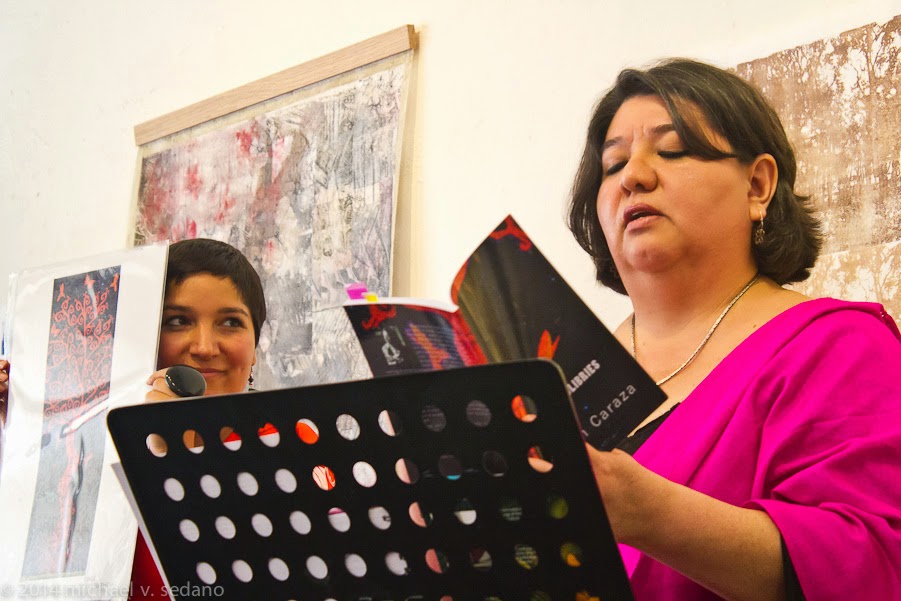















 With all this reading in overdrive, it is understandable that few students (and teachers) want to keep reading at home for pleasure. Yet we need to sustain student excitement for reading and prevent testing anxiety. Now more than ever, students need the bigger picture of how literacy helps us as citizens, the experiences of deriving joy from print, and practice using books for stress management.
With all this reading in overdrive, it is understandable that few students (and teachers) want to keep reading at home for pleasure. Yet we need to sustain student excitement for reading and prevent testing anxiety. Now more than ever, students need the bigger picture of how literacy helps us as citizens, the experiences of deriving joy from print, and practice using books for stress management.



Amelia and Eleanor Go for a Ride by Pam Munoz Ryan, of course! :)
Hi Miss Amy-
Thank you for recommending the book, Amelia and Eleanor Go For A Ride, as a book pairing to the article about the discovery of Amelia Earhart’s plane fragment. This is a fantastic story about persistence, courage, and overcoming obstacles. I could see students engaging on additional research projects and personal narratives with this pairing!